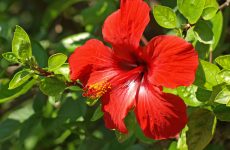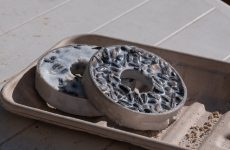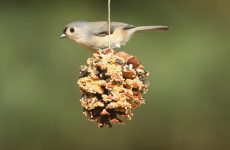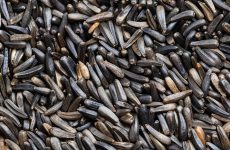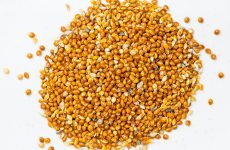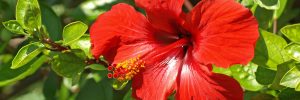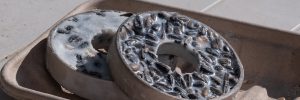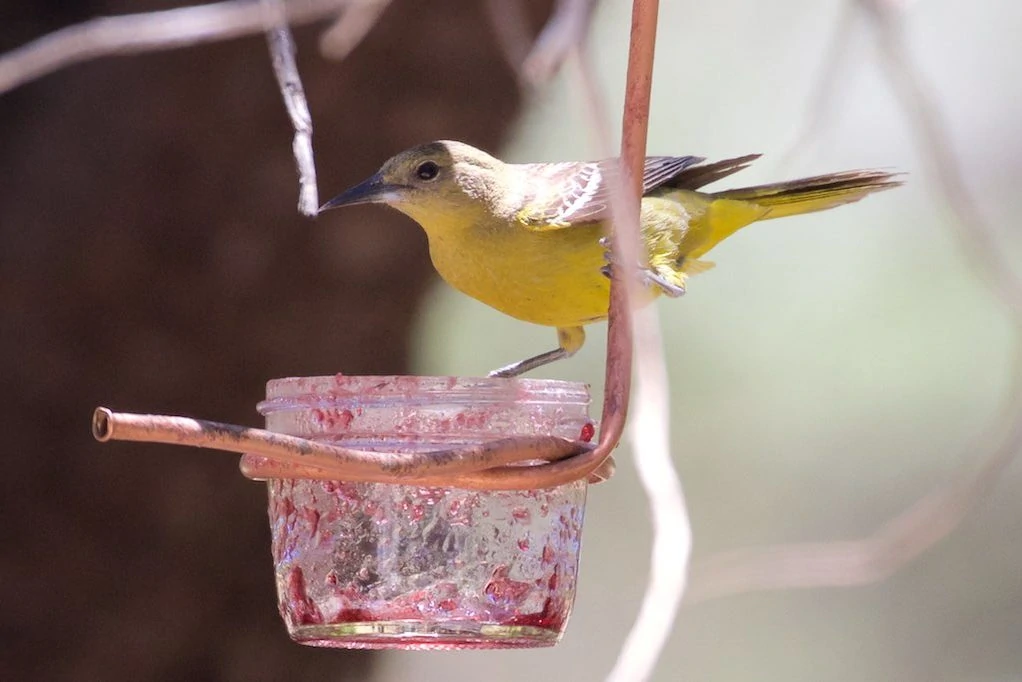
This guide will tell you all you need to know about what birds eat jelly with identification guides and pictures. Also, get an easy grape jelly recipe for birds and find out how and when to feed birds grape jelly.
Grape Jelly is loved by birds, especially tanagers and orioles but other fruit-eating birds such as catbirds, woodpeckers, House Finch, robins, Yellow-rumped Warblers, grosbeaks, Cape May Warbler, Brown Thrashers, and Northern Mockingbirds.
You can buy bird-specific grape jelly in stores that are better for them, or you can make your own. You don’t only have to feed grape jelly, but birds prefer dark-colored jellies such as grape, blackberry, or raspberry.
You should only put out jelly during the spring and fall migration when birds need the extra energy as jelly lacks the important nutrients that real fruit gives and is more of a quick energy hit.
If you do put it out more often, don’t feed too much jelly in one go to birds and save it for an occasional treat.
You should also only offer jelly in small quantities in a shallow dish or the empty skin of half an orange, as birds can be stuck in the sticky jelly and die if too deep. Only offer around a spoonful at a time.
If you use bird feeders for grape jelly, then use ones with shallow trays that have perches, such as this Birds Choice Feeder.
Hummingbirds may also eat grape jelly, but as they are so tiny, the jelly is especially dangerous as it is so sticky, so make sure there is only a small amount.
Squirrels will also eat grape jelly, but if you only put out small amounts, it can help prevent them from eating it all!
Homemade jelly is best as store-bought jelly can contain high fructose corn syrup, so try this simple recipe to make your own grape jelly for orioles and other birds.
This site is reader-supported and as an Amazon Associate, I earn a commission if you purchase a product I recommend at no extra cost to you.
Easy Recipe For Grape Jelly For Birds
Ingredients:
- 3 cups of bottles of unsweetened concord grape juice
- 11.75 ounces powdered pectin
- 4 1/2 cups of sugar
Method:
- In a heavy pot, combine the grape juice and pectin and bring to a boil while stirring constantly.
- Stir in the sugar
- Return to the boil, stirring constantly, and boil for 1 minute
- Remove from heat and pour into sterilized canning jars
22 Birds That Eat Grape Jelly:
1. Baltimore Oriole
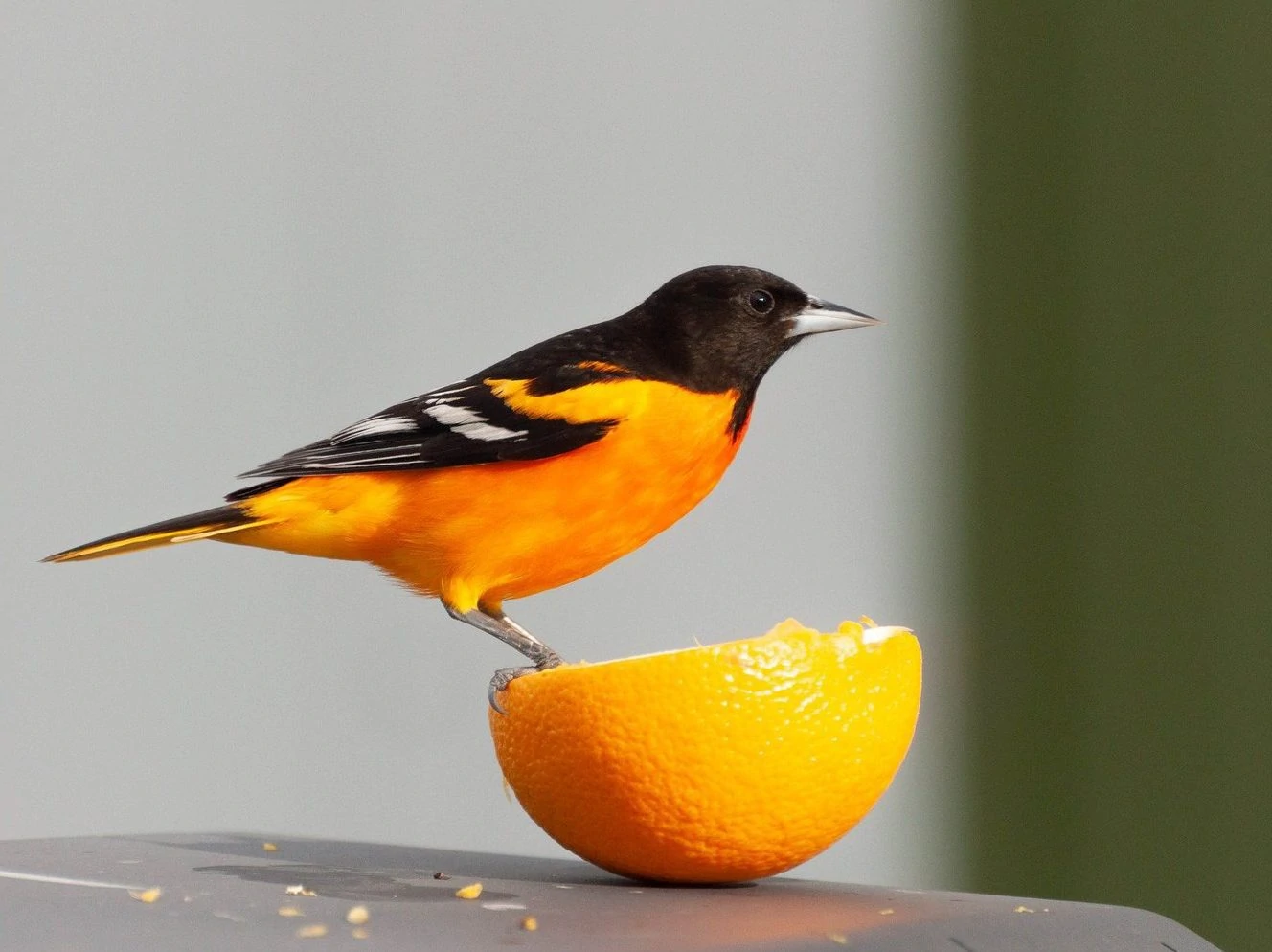
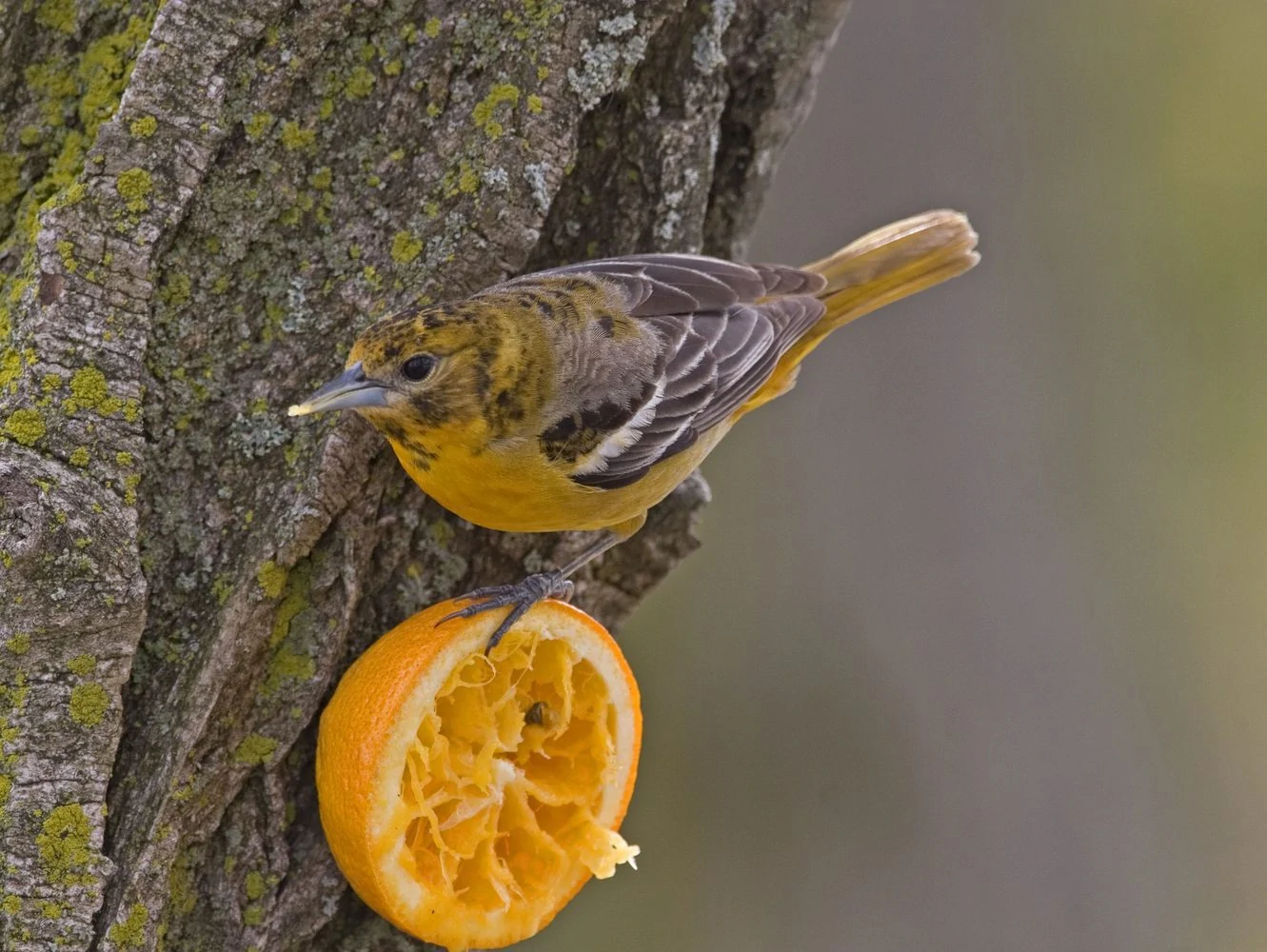
Baltimore Orioles are a colorful sign of spring in the east of North America. The adult males are bright orange and black with white wing bars on the black wings.
Females are yellowish underneath and on the head and grayish-brown on the wings, their backs or brownish-yellow. They are about the size of a Robin but more slender and are members of the blackbird family.
- Icterus galbula
- Length: 6.7-7.5 in (17-19 cm)
- Weight: 1.1-1.4 oz (30-40 g)
- Wingspan: 9.1-11.8 in (23-30 cm)
Baltimore Orioles breed in Eastern and Central States, including central-southern Canadian provinces and along the southern border with the US.
Baltimore Orioles then migrate to Florida, Central America, and the Caribbean for winter, leaving as early as July.
Baltimore Orioles can be found high up in open woodland, riverbanks, and forest edges foraging for insects and fruit, and they often come to parks and backyards.
Their diet is insects such as beetles, crickets, and grasshoppers, as well as spiders and snails. They also help eat pest species and eat a wide variety of fruits, and they can damage crops such as raspberries, mulberries, cherries, bananas, and oranges.
Baltimore Oriole sounds: The flute-like sound of Baltimore Orioles is one of the joys of spring. They also make chattering and sharp alarm calls.
Attract Baltimore Orioles to your backyard with oranges cut in half on a platform feeder or hanging them from trees. Also, try oriole feeders filled with sugar water. Planting some fruiting plants and nectar plants such as raspberries, crab apples, and trumpet vines should also attract them.
Fun fact: Baltimore Orioles make incredible hanging bag-like nests woven from fibers.
2. Gray Catbird
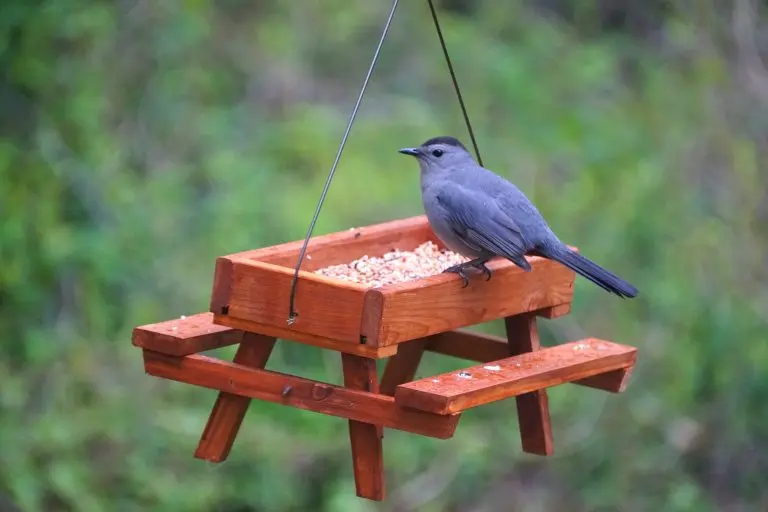
Gray Catbirds are so named because of their distinctive catty mew song that can last for up to 10 minutes. They are medium-sized songbirds with a slate gray coloring, black cap and tail, and a reddish patch under their tails.
- Dumetella carolinensis
- Length: 8.3-9.4 in (21-24 cm)
- Weight: 0.8-2.0 oz (23.2-56.5 g)
- Wingspan: 8.7-11.8 in (22-30 cm)
Gray Catbirds breed in the Midwest, eastern US states, and southern Canada before heading to the Gulf Coast and the Caribbean for winter. Some remain all year along the East Coast.
You can spot Gray Catbirds in dense shrubs, small trees, and along forest edges or hedgerows. They are named after their ‘mew’ sounding call.
Gray Catbird Call:
Attract Gray Catbirds to your backyard with fruit and fruit trees or shrubs such as dogwood, winterberry, and serviceberry.
3. Orchard Oriole
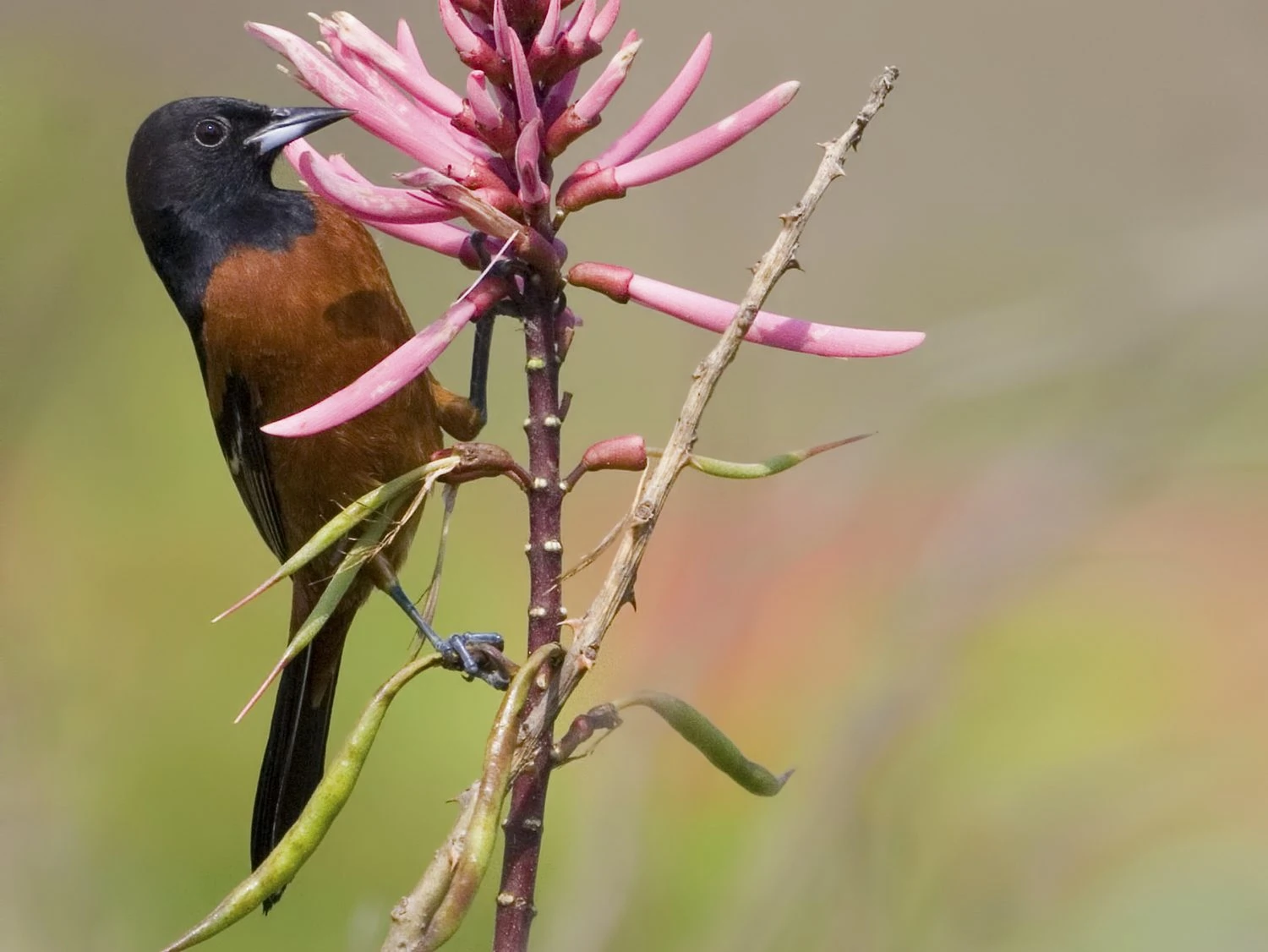
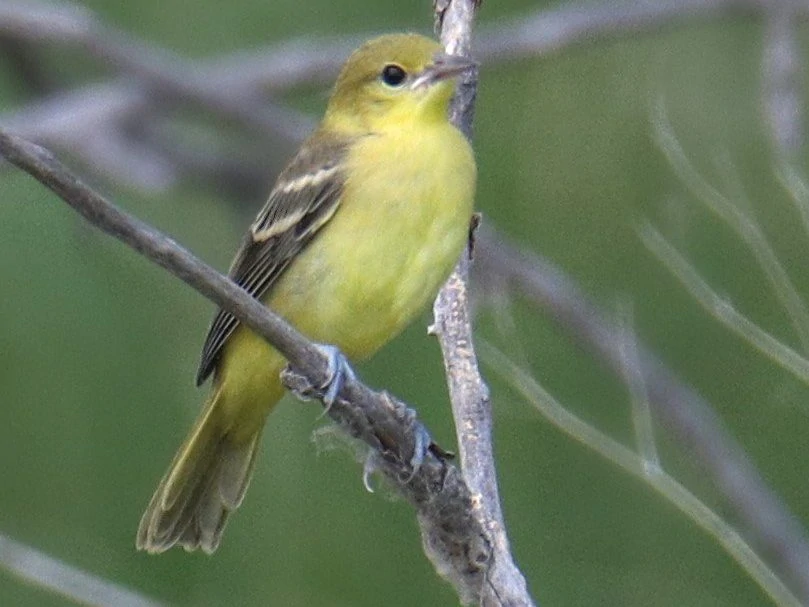
Orchard Orioles females are greenish-yellow overall, paler underneath and darker on the back, with darker wings and white wingbars.
Males look very different with very bold coloring. They have black heads and backs and reddish undersides.
- Icterus spurius
- Length: 5.9-7.1 in (15-18 cm)
- Weight: 0.6-1.0 oz (16-28 g)
- Wingspan: 9.8 in (25 cm)
In summer, Orchard Orioles breed in the eastern half of the United States before migrating south to Mexico and Central America.
Preferring open woodland, Orchard Orioles can also be found along river banks and open shrubland and farms as well as backyards. They build hanging pouch-like nests.
Their diet is mostly insects such as ants, caterpillars, beetles, and grasshoppers, as well as spiders. They will also drink nectar from flowers and eat fruit such as mulberries and chokeberries.
Orchard Oriole sounds: They make a jumbled series of whistles that lasts about 3 to 4 seconds.
Nests of Orchard Orioles are a cup made from long grasses suspended from small branches of trees. They lay 4 – 6 eggs, which take about two weeks to hatch.
Attract Orchard Orioles to your yard with hummingbird feeders or platform feeders with cut oranges or mango. Also, plant native berry plants such as mulberries or chokeberries.
Fun fact: Orchard Orioles are the smallest species of blackbird in North America
4. American Robin
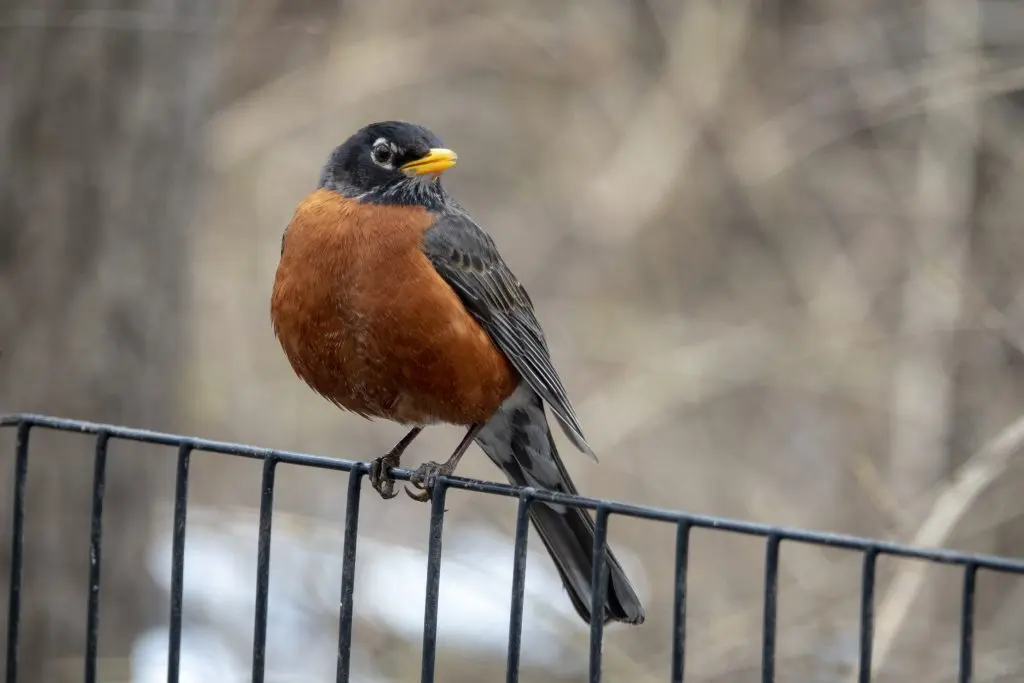
American Robins are a common sight on lawns eating earthworms. They have black heads and backs with red or orange breasts. They tend to roost in trees in winter, so you are more likely to see them in your backyard from spring.
- Turdus migratorius
- Length: 7.9-11.0 in (20-28 cm)
- Weight: 2.7-3.0 oz (77-85 g)
- Wingspan: 12.2-15.8 in (31-40 cm)
American Robins are residents in the lower 48 and the coast of Western Canada and Alaska. Those that breed in Canada and inland Alaska move south for the winter.
American Robins can be found in many habitats, from woodlands, forests, mountains to fields, parks, and lawns. They eat earthworms, insects, snails, and fruit.
American Robin Song:
American Robin Call:
Attract American Robins to your backyard with sunflower seeds, suet and peanut hearts, fruit, and mealworms. Platform feeders are best or food scattered on the ground. Also, try planting some native plants that produce berries, such as juniper, sumac, hawthorn, and dogwood.
5. Bullock’s Oriole
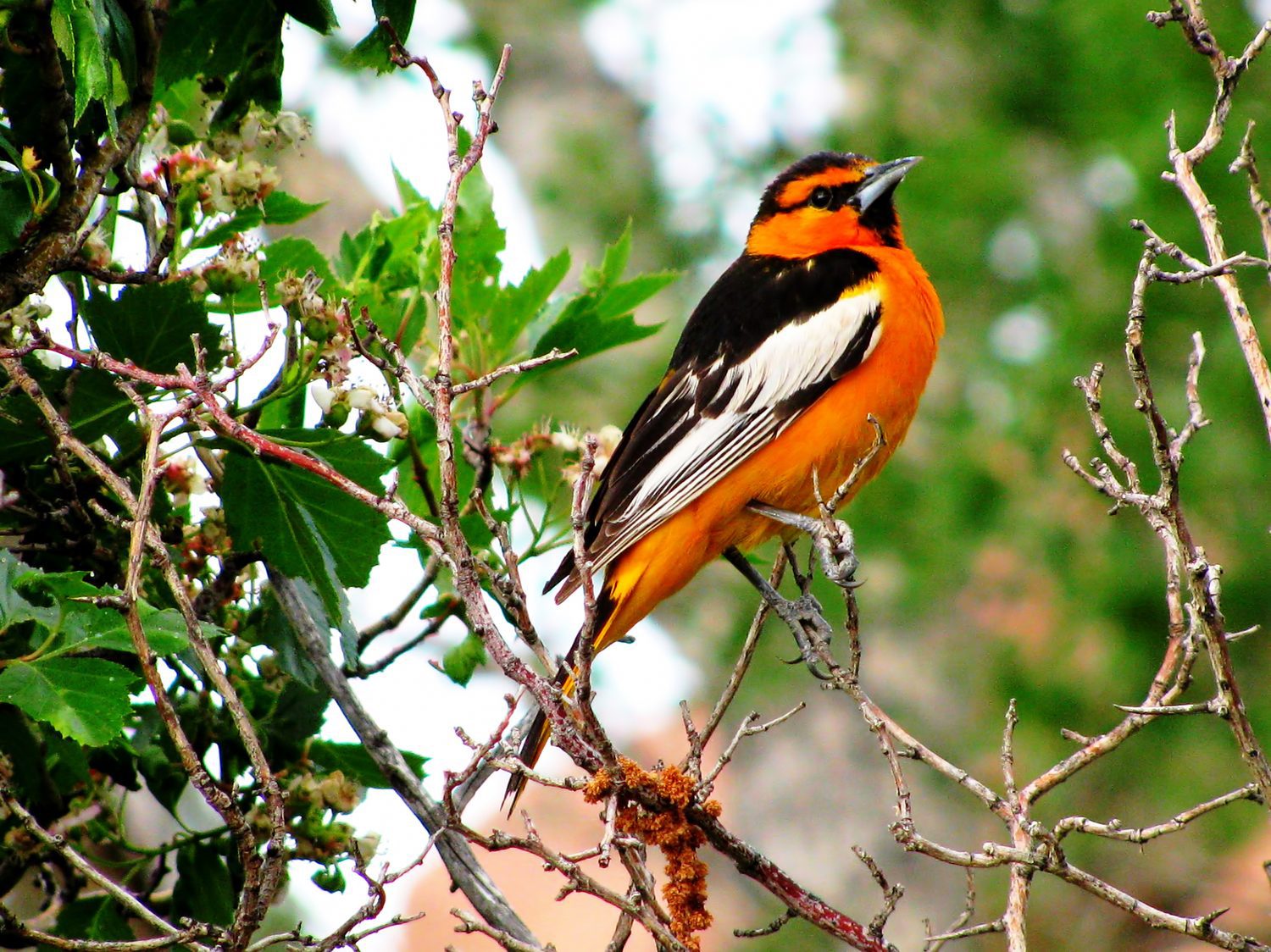
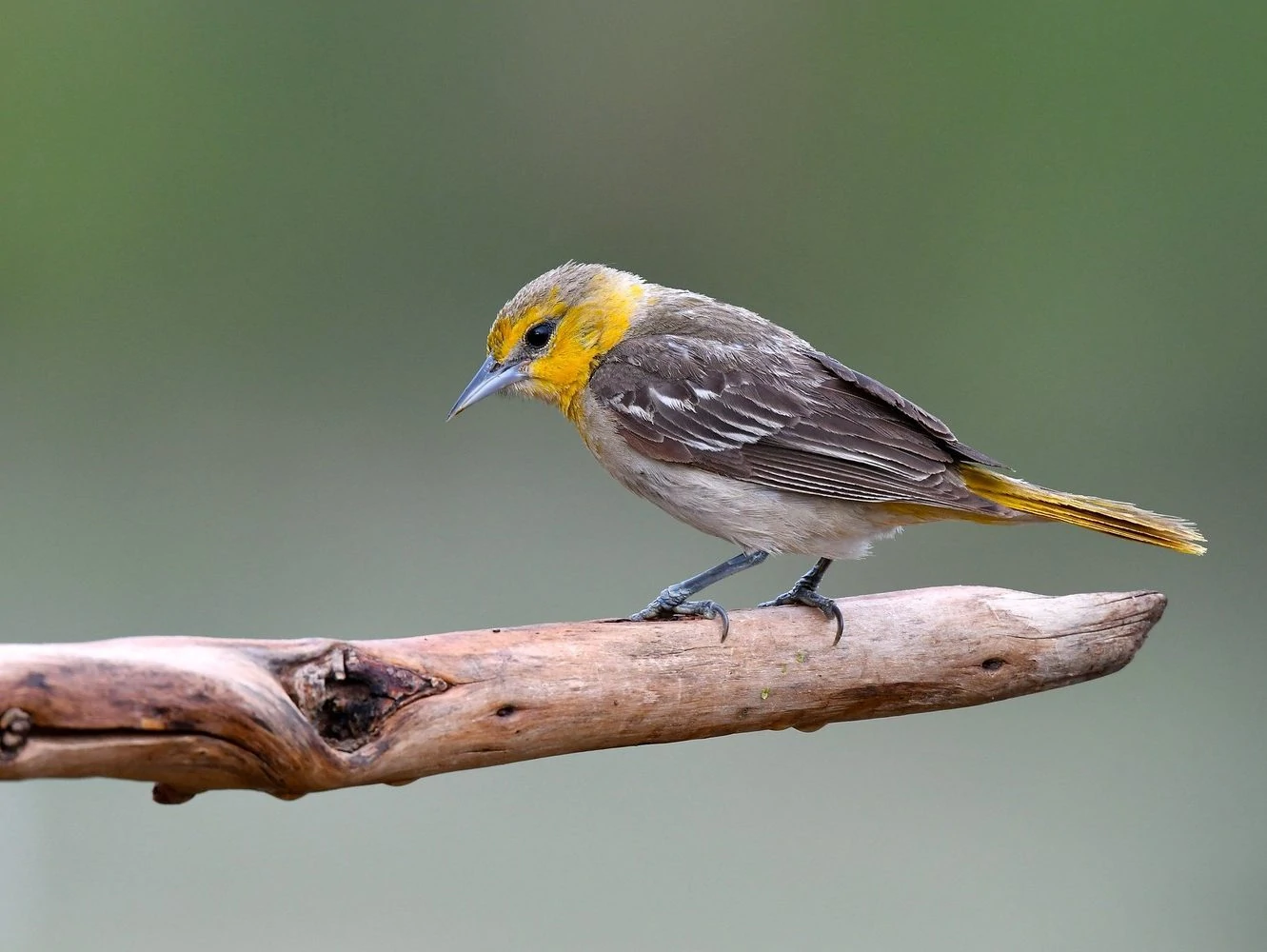
Bullock’s Orioles males are bright orange with black and white wings and black markings on their heads.
Females and immature are duller with gray backs and yellow heads, tails, and chests.
- Icterus bullockii
- Length: 6.7-7.5 in (17-19 cm)
- Weight: 1.0-1.5 oz (29-43 g)
- Wingspan: 12.2 in (31 cm)
Bullock’s Orioles breed in the western half of the US and spend the winter in Mexico.
You can find Bullock’s Orioles in open woodlands and parks foraging for insects, fruit, and nectar.
Bullock’s Oriole sounds: They make a series of cheeps and whistles that last a few seconds.
Attract Bullock’s Orioles to your backyard with sugar water, jelly and fruit.
Fun fact: Their nests are woven from hair, grass, and wool into a gourd shape and take up to 15 days to complete.
6. Hooded Oriole
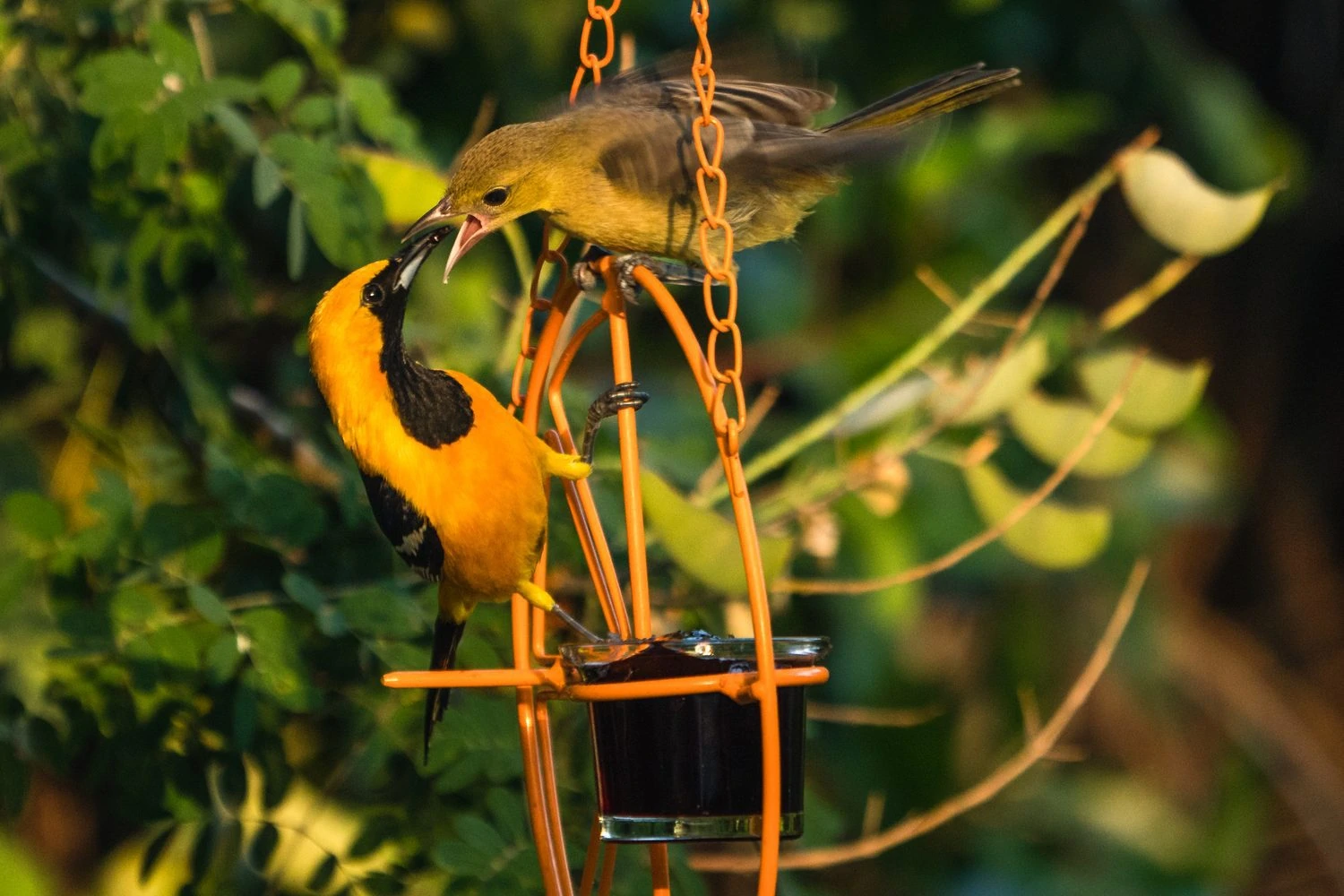
Male Hooded Orioles range from bright yellow to bright orange, with black throats and backs. Females and immatures are more yellow with grayish wings. Females also lack the black face markings that males have.
- Icterus cucullatus
- Length: 7.1-7.9 in (18-20 cm)
- Weight: 0.8 oz (24 g)
- Wingspan: 9.1-11.0 in (23-28 cm)
Hooded Orioles breed in the southern US states, making hanging nests on the undersides of palm fronds. They winter in Mexico, and some remain all year on the Gulf Coast of Mexico and Central America.
Some Hooded Orioles have stopped migrating from southern US states because of the ready food supply from nectar feeders and fruit left out by birdwatchers. They live in dry open areas, especially near palm trees.
Hooded Oriole sounds: The males’ song is a jumbled mix of whistles and warbles. Females’ songs are less complex, and they both have sharp calls.
Nest of Hooded Orioles are high at around 20 feet off the ground and are a hanging baskets weaved from grass and plant material.
Attract Hooded Orioles to your backyard with sugar water, jelly, and oranges.
Fun fact: Hooded Oriole males in Texas tend to be orange in color, but those further west are yellow.
7. House Finch
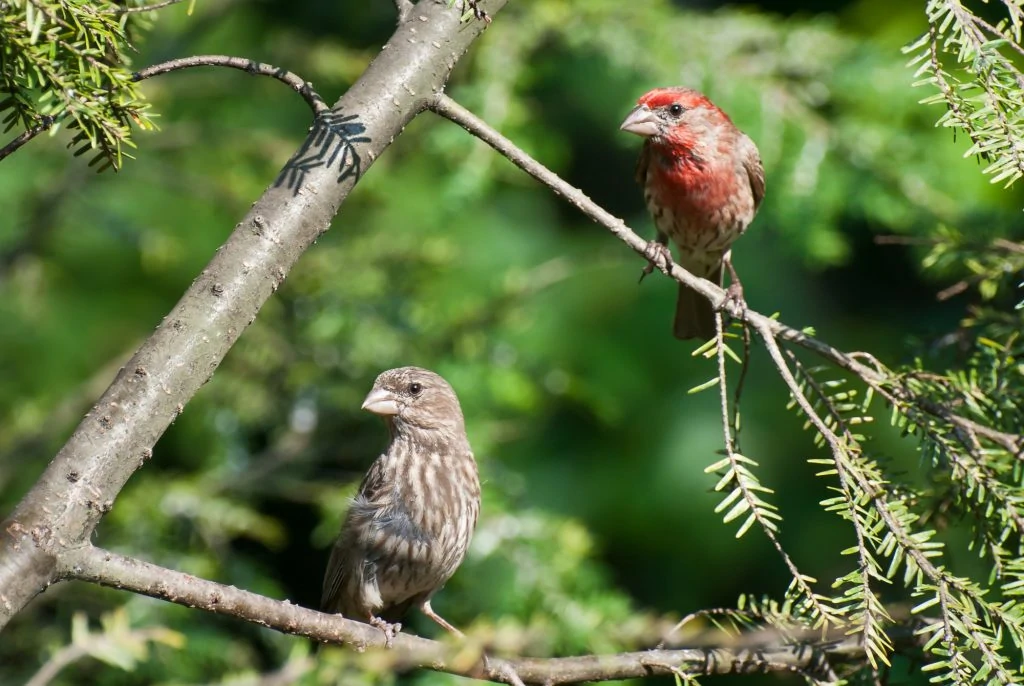
House Finches males have a red head and breast, and the rest of their bodies are mainly brown-streaked. Females are brown-streaked all over.
- Haemorhous mexicanus
- Length: 5.1-5.5 in (13-14 cm)
- Weight: 0.6-0.9 oz (16-27 g)
- Wingspan: 7.9-9.8 in (20-25 cm)
Originally only in western US states, House Finches were introduced to eastern US states and have done very well, even pushing out the Purple Finch.
They can be found in parks, farms, forest edges, and backyard feeders in noisy groups that are hard to miss.
House Finch Song:
House Finch Call:
Attract House Finches to backyard feeders with black oil sunflower seeds or nyjer seeds in tube feeders or platform feeders.
8. Scott’s Oriole
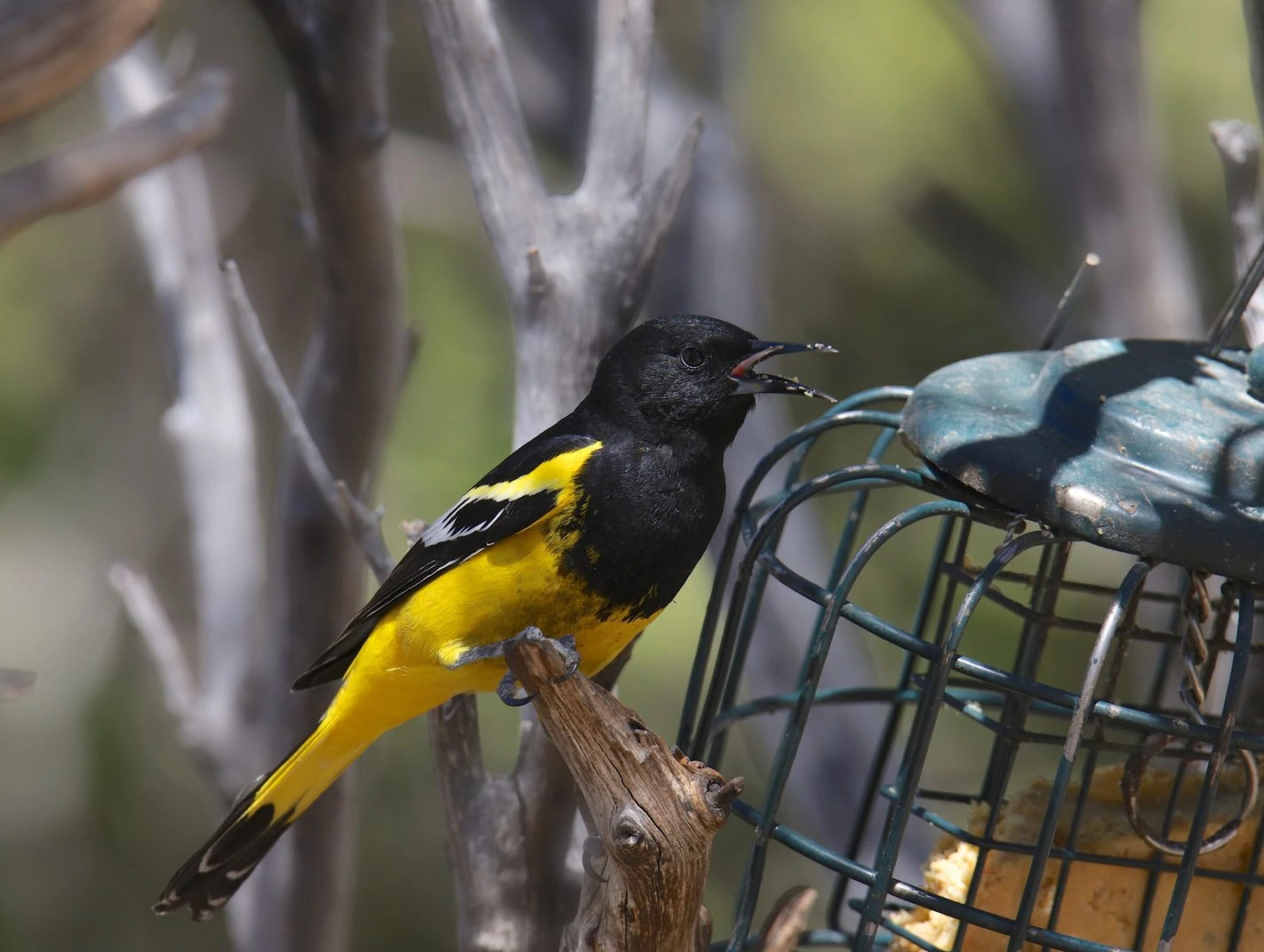

A large distinctive oriole with a bright yellow underside and black head and back in the males. Females are a paler yellow with olive-brown backs.
- Icterus parisorum
- Length: 9.1 in (23 cm)
- Weight: 1.1-1.4 oz (32-41 g)
- Wingspan: 12.6 in (32 cm)
Scott’s Orioles breed in southwestern US states and northern Mexico before migrating south for winter. They also remain all year in southern Mexico and Baja California.
You can find Scott’s Orioles on higher slopes in arid areas feeding on insects, nectar, and fruit. They are often found on yuccas and begin singing before dawn.
Scott’s Oriole sounds: Their song is a sweet series of whistles and is less jumbled than some orioles songs.
Nests are often quite low down at only 5 – 7 feet and are a basket of cactus fibers, grass, and yucca leaf. They may have 2 or 3 broods in a year.
Attract Scott’s Orioles to your backyard with sugar water, jelly, and oranges.
Fun fact: Scott’s Orioles will feed on toxic monarch butterflies by finding the ones with the least toxins and eating those.
9. Altamira Oriole
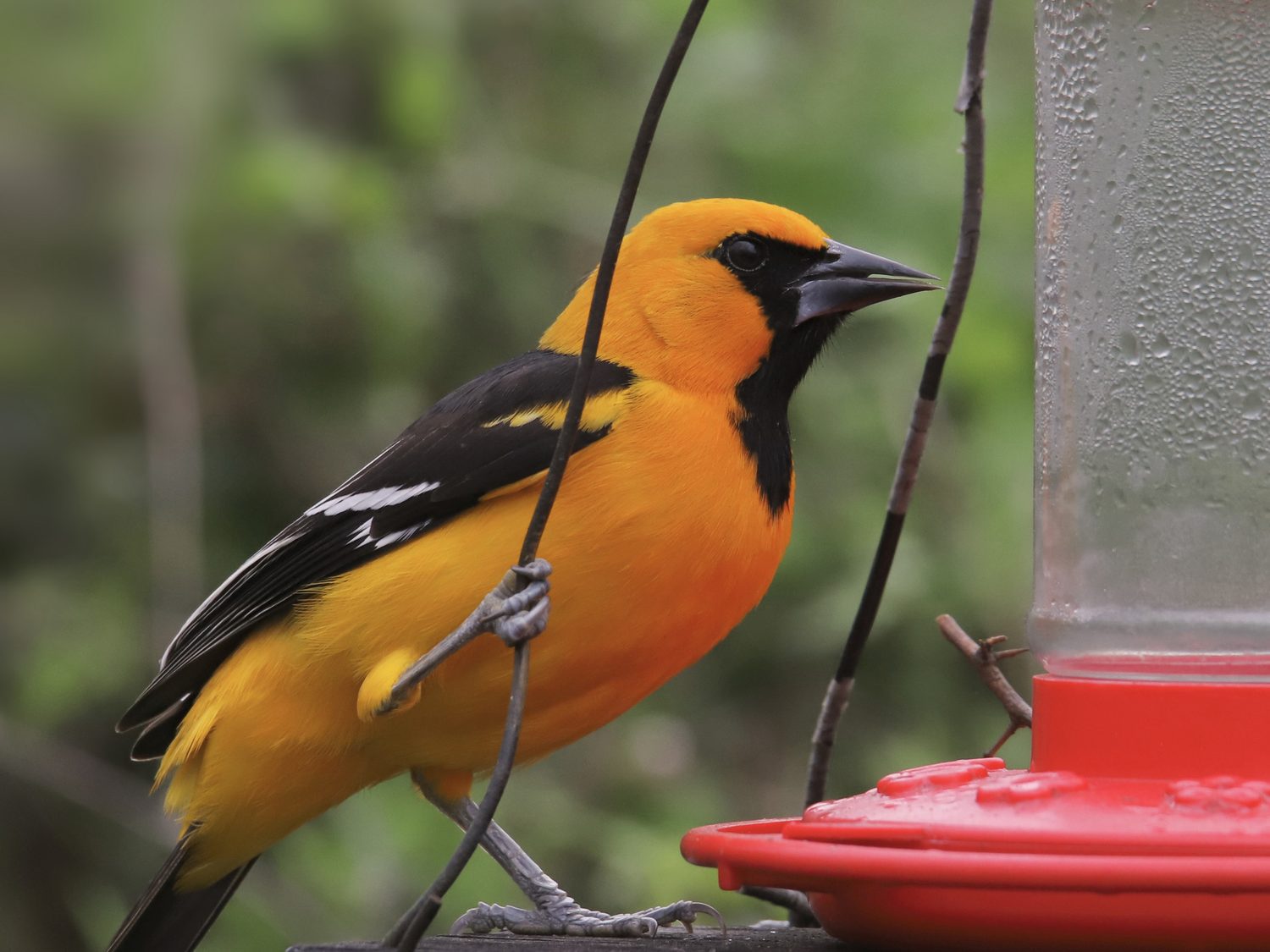
Altamira Orioles are bright yellowish-orange with black backs, wings, and tails. They also have black around the eyes and down the throat. Males and females look the same, but juveniles are more yellow and have olive backs rather than black.
- Icterus gularis
- Length: 8.3-9.8 in (21-25 cm)
- Weight: 1.7-2.3 oz (47-64 g)
- Wingspan: 14.2 in (36 cm)
Altamira Orioles are rare in the US except in the Rio Grande Valley, Texas, and they remain year-round.
Look for them in backyards at sunflower or nectar feeders or in wildlife refuges in southeastern Texas and along the Gulf Coast of Central America. They prefer open woodlands.
Altamira oriole sounds: Altramire Orioles’ song is a series of raising and falling whistles, and their call is a clipped sound. They also make harsh shattering noises.
Attract Altamira Orioles to your backyard with sugar water, oranges, jelly, and sunflower seeds.
Fun fact: Altamira Orioles stay in their breeding pairs year-round and build unique hanging nests that measure up to 2 feet long.
10. Audubon’s Oriole
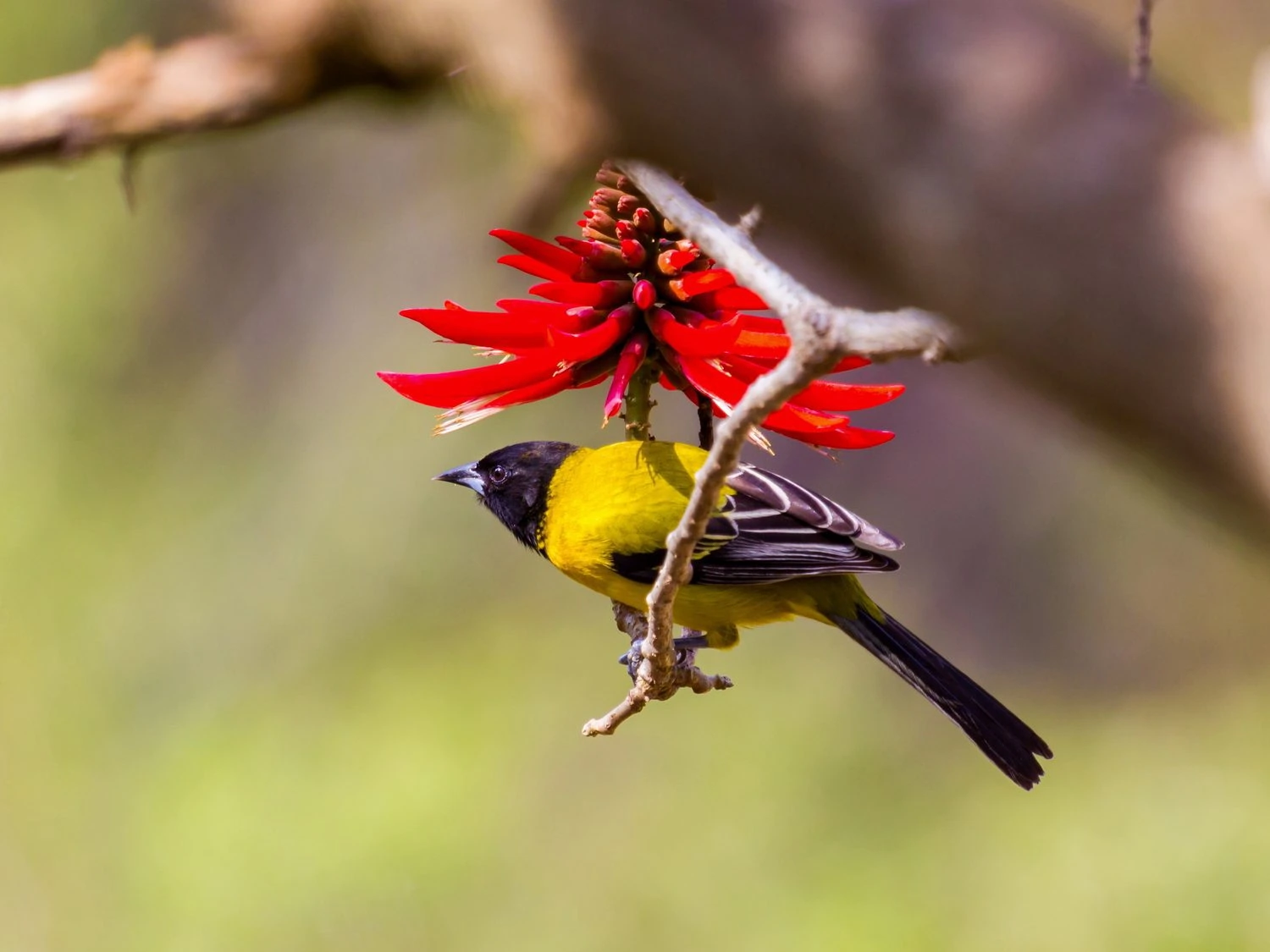
Audubon’s Orioles are bright yellow and black with black wings and tails. They also have black heads and throats. Males and females are similar.
- Icterus graduacauda
- Length: 7.5-9.4 in (19-24 cm)
- Weight: 1.1-1.9 oz (31-53 g)
- Wingspan: 12.6 in (32 cm)
They have a small range and do not migrate. Audubon’s Orioles live in southeastern Texas and Mexico.
Audubon’s Orioles can be found in wooded areas or thickets, but they can be hard to see as they are shy and forage for insects and fruit in thick vegetation.
Audubon’s Oriole sounds: Audubon’s Orioles’ song is a rising and falling whistle. They also make short high-pitched calls and harsh, chattering sounds.
Attract Audubon’s Orioles to your backyard with sugar water and sunflower seeds.
Fun fact: The nests of Audubon’s Orioles are often the favored new homes for cowbird eggs.
11. Spot-breasted Oriole
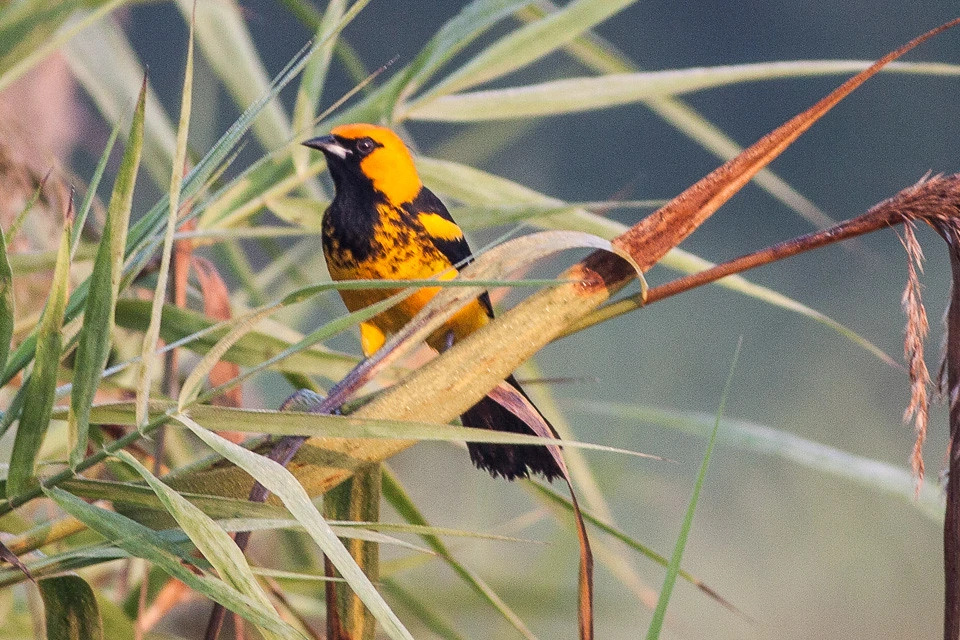
Credit: Ron Knight
Spot-breasted Orioles are black and orange birds with black spotting on their breast and white on the wing edges. They have black around the face and chest and are black on the back, wings, and tail.
Juveniles are more yellow in color with dark backs, wings, and tails.
- Icterus pectoralis
- Length: 8.3-9.4 in (21-24 cm)
- Weight: 1.8 oz (50 g)
Spot-breasted Orioles can be found in Florida and along the Gulf Coast, but they are not very common in the US. Instead, they mostly live in Mexico and the Pacific Coast of Central America.
They live in open woodlands and dry scrub and will come to more urban areas.
Spot-breasted Oriole sounds: Their song is a tuneful series of whistles, and their calls are harsh and loud.
Attract Spot-breasted Orioles to your backyard with fruit and sugar water.
Fun fact: Nests of Spot-breasted Orioles are made from plants and fibers weaved into a long hanging pouch from a tree.
12. Streak-backed oriole
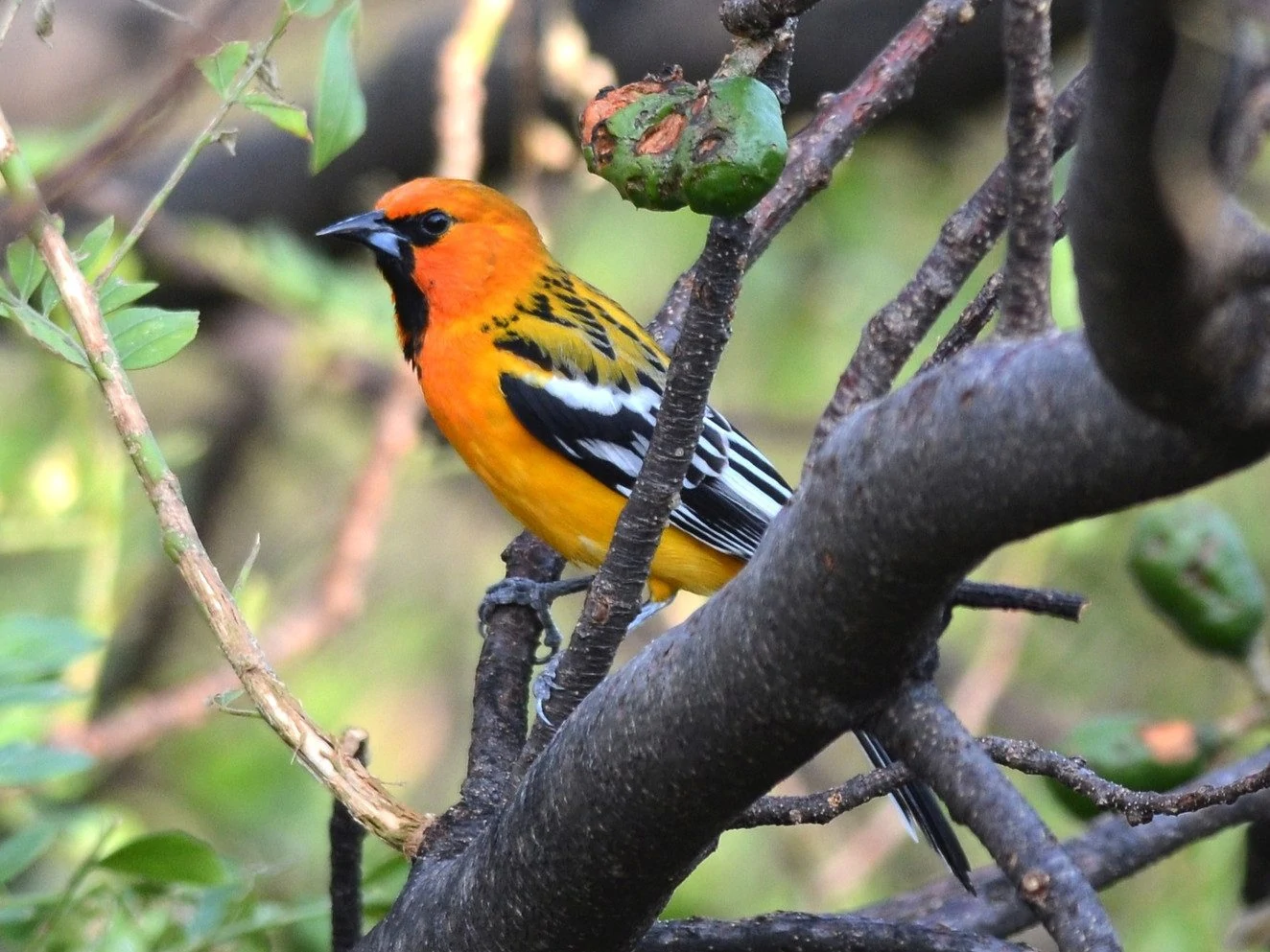
Credit: Oregon State University
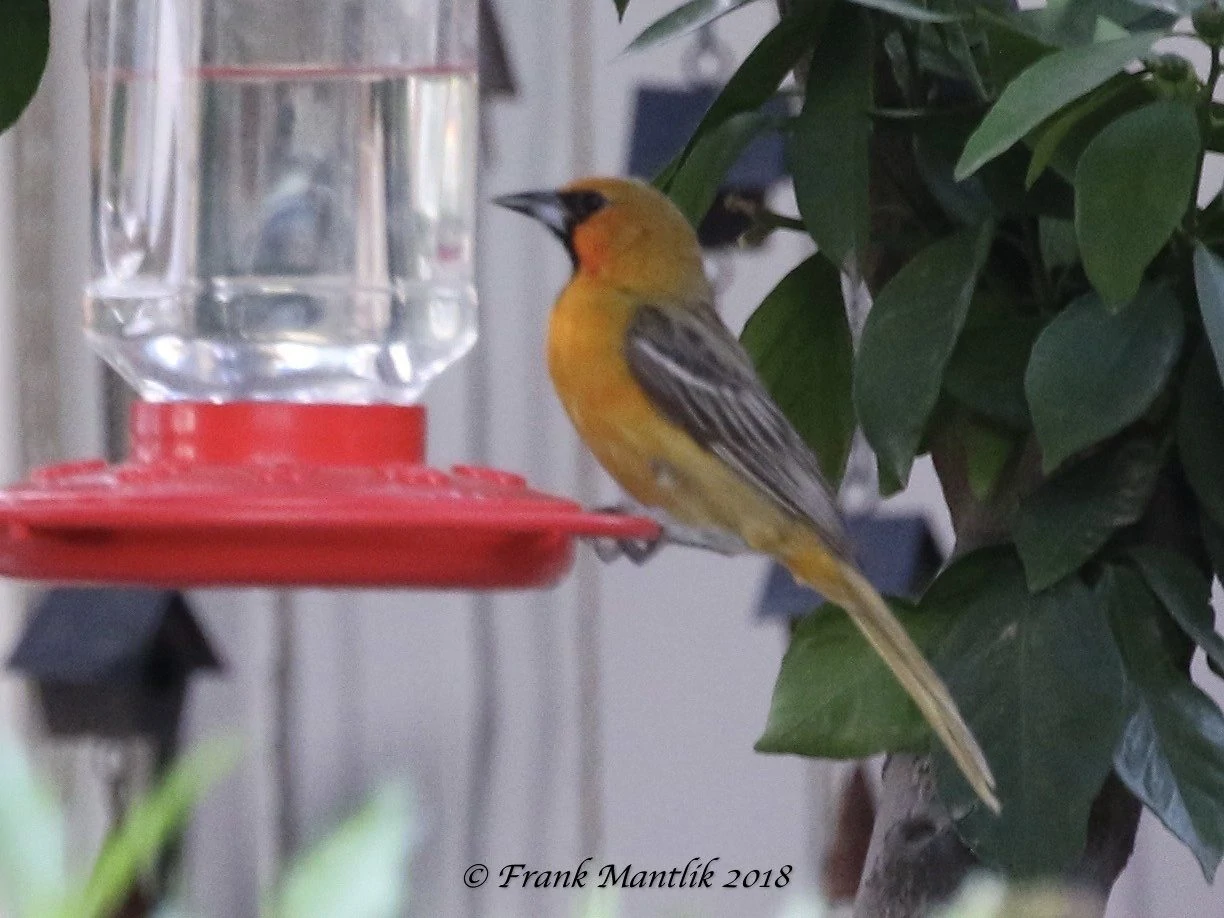
Credit: Frank Mantlik
Streak-backed Orioles are orange and black orioles with orange heads and undersides, black-streaked wings, and a black tail. They have black around the eyes and chin.
- Icterus pustulatus
- Length: 8.25 in (21 cm)
- Weight: 1.3 oz (36.8 g)
- Wingspan: 12.5 in (31.7 cm)
Streak-backed Orioles are not often spotted in the US, but they can be seen in the southwest. They are usually found along the Pacific Coast of Mexico and Central America, where they are very common.
They are usually alone or in small groups found in tropical woodland, grassland, and backyards, often along rivers.
Streak-backed Oriole sounds: Their song is a series of pleasant whistles, and calls are short sharp notes or cackles.
Nests of Streak-backed Orioles are long hanging baskets from weaved plant fibers. They lay 3 – 4 eggs, and they take about two weeks to hatch and a further two weeks to fledge.
13. Black-vented Oriole
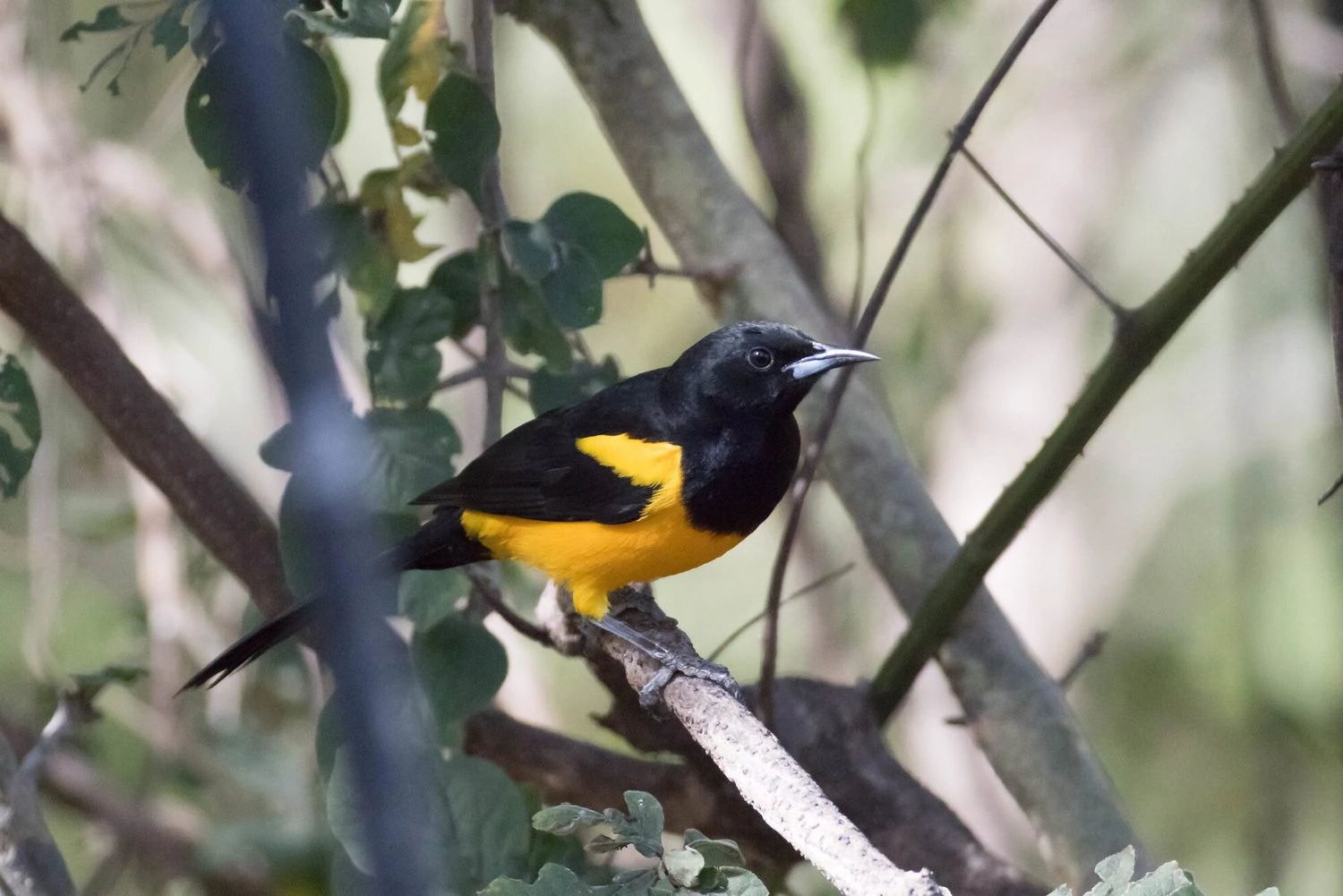
Black-vented Orioles males and females have the same black and yellow pattern. Their heads, chest, backs, wings, and tails are black, and they have bright yellow undersides.
- Icterus wagleri
- Length: 8.7 in (22 cm)
- Weight: 1.5 oz (42.5 g)
- Wingspan: 14 in (35.6 cm)
Black-vented Orioles are from Mexico and Central America, but they do stray north into southern states such as Texas.
They feed mainly on insects and spiders but will also eat seeds and fruit and will visit backyard feeders.
14. Yellow-rumped Warbler
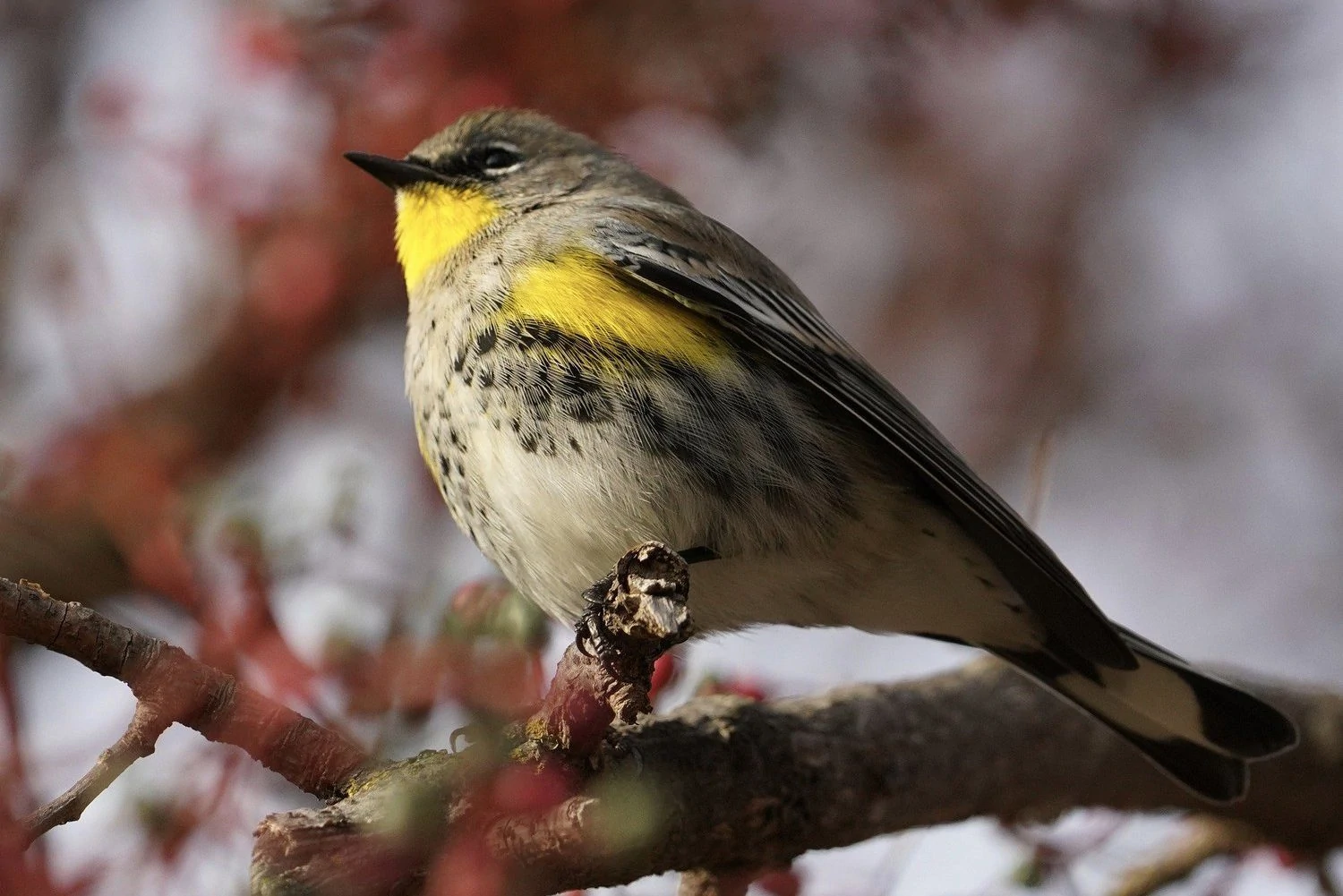
Yellow-rumped Warblers are gray with flashes of yellow on the face, sides, and rump and white in the wings.
Females may be slightly brown, and winter birds are paler brown with bright yellow rumps and sides turning bright yellow and gray again in spring.
- Setophaga coronata
- Length: 4.7-5.5 in (12-14 cm)
- Weight: 0.4-0.5 oz (12-13 g)
- Wingspan: 7.5-9.1 in (19-23 cm)
Yellow-rumped Warblers breed predominantly in Canada and parts of the Rockies and the Appalachian mountains.
During migration, they can be seen in the Midwest before overwintering in southern and southwestern US states and the Pacific Coast and into Mexico and Central America.
You can find Yellow-rumped Warblers in coniferous forests, especially during the breeding season. During winter, they can be found in open areas with fruiting shrubs. In summer, they eat mostly insects and on migration, and in winter, they eat mostly fruit, including bayberry and wax myrtle.
Yellow-rumped Warbler Song:
Attract Yellow-rumped Warblers to your backyard with sunflower seeds, suet, raisins, and peanut butter.
15. Scarlet Tanager
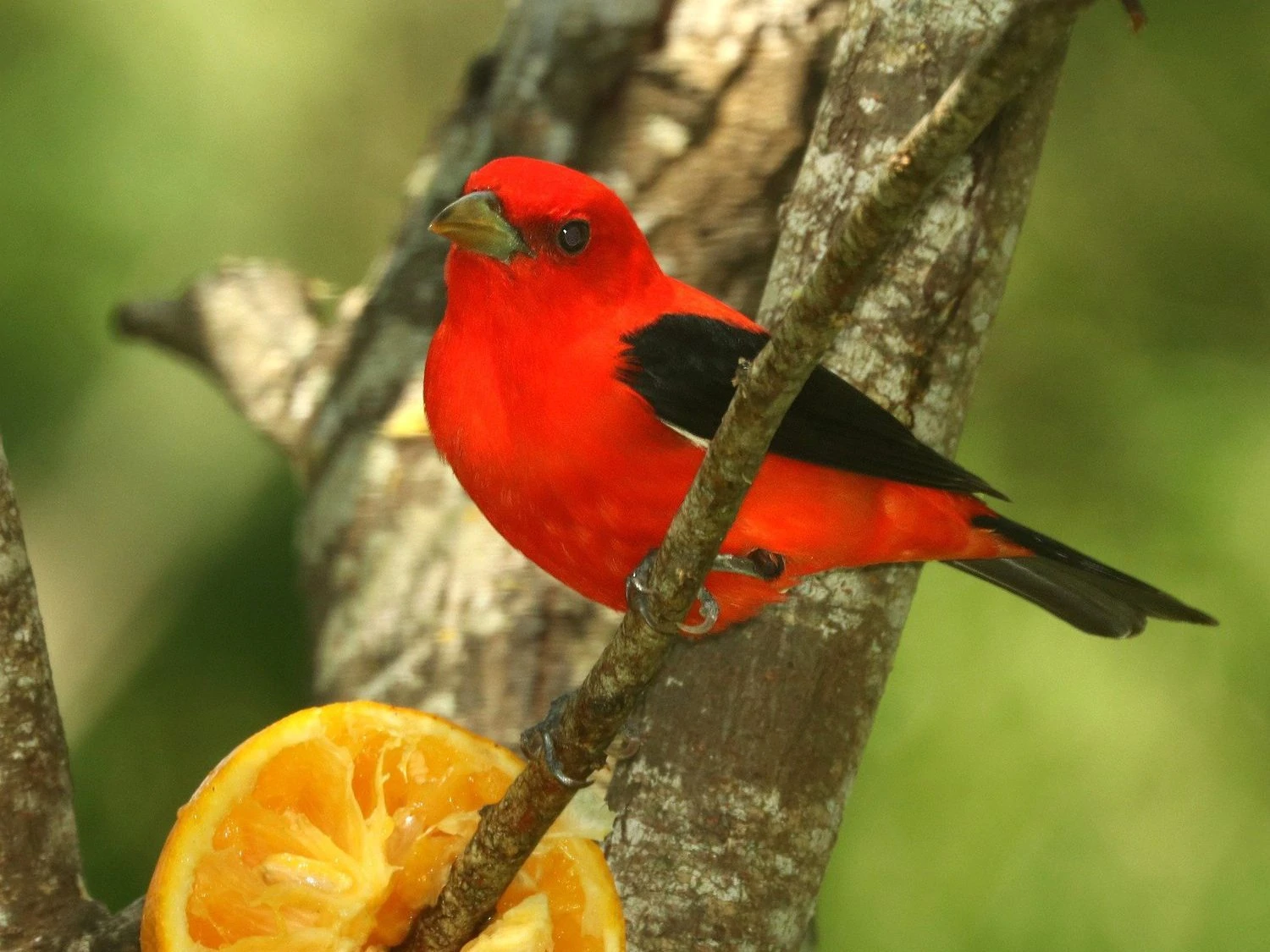
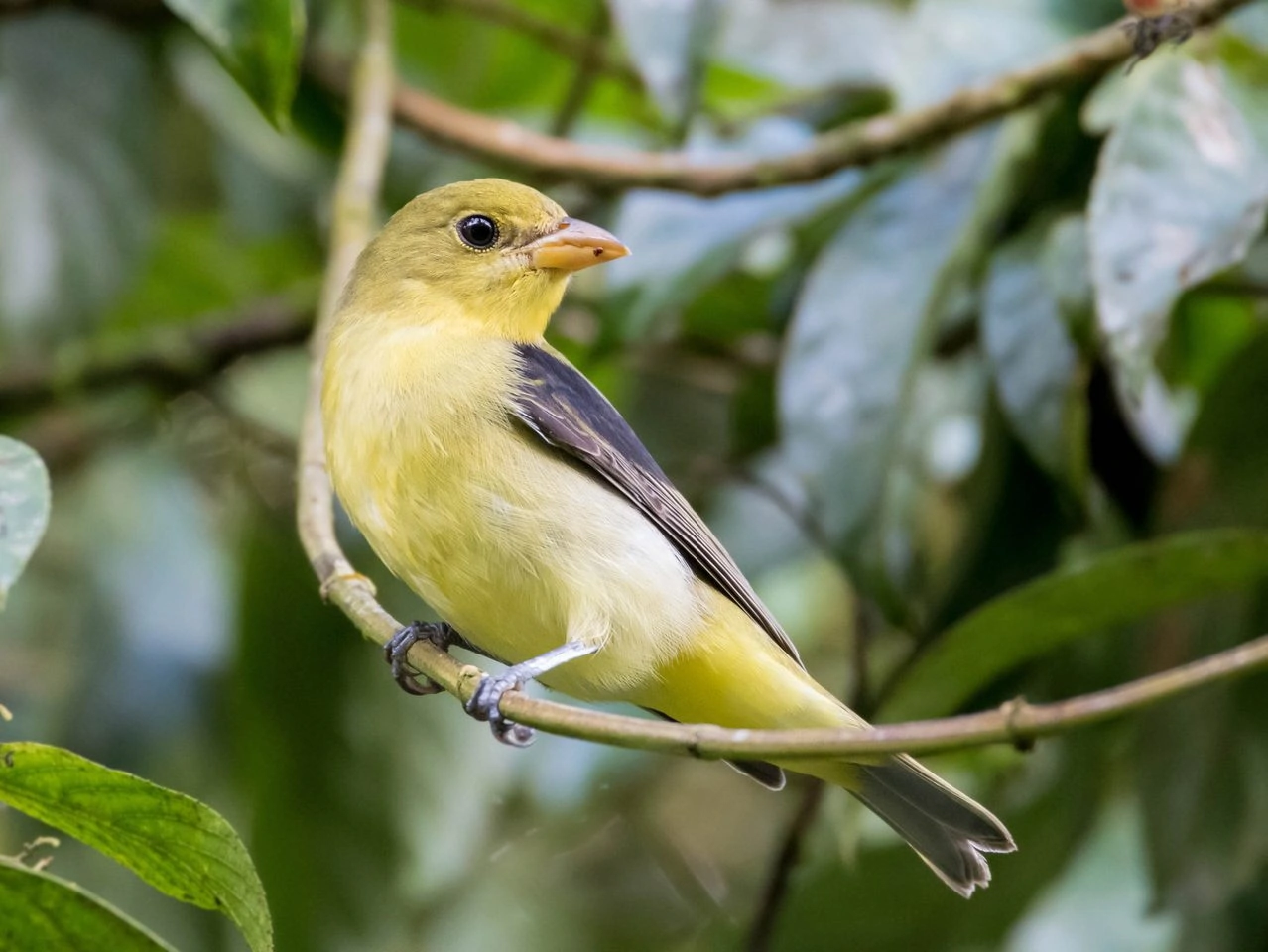
Scarlet Tanagers are bright red birds with black wings and tails. Females are yellow with darker wings and tails, as are the males after molting. Their bills are thick, and they have pretty short tails.
- Piranga olivacea
- Length: 6.3-6.7 in (16-17 cm)
- Weight: 0.8-1.3 oz (23-38 g)
- Wingspan: 9.8-11.4 in (25-29 cm)
In summer, Scarlet Tanagers breed in eastern forests before migrating to western South America. They can be spotted in southeastern states during their migrations.
Scarlet Tanagers can be hard to spot as they stay high in the forest canopy, but you may see a flash of red as they walk along branches looking for insects.
Scarlet Tanager Song:
Nests of Scarlet Tanagers are built by females in only around four days from loosely woven twigs, grass, and plant material. The inside is lined with soft grass, pine needles, and other soft material. They lay around four eggs, which take two weeks to hatch and up to two weeks for the young to fledge.
Attract Scarlet Tanagers by planting berry plants such as blackberries, raspberries, huckleberries, juneberries, serviceberries, mulberries, strawberries, and chokeberries.
Fun fact: Male Scarlet Tanagers have singing battles which sometimes spill over into actual fighting.
16. Summer Tanager
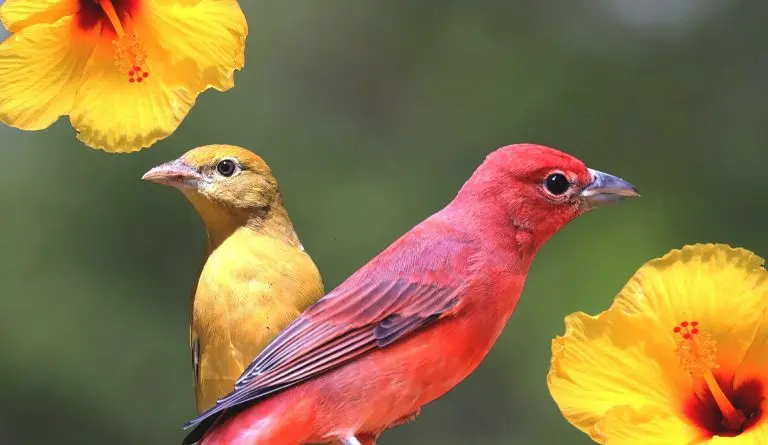
Summer Tanager males are bright red birds with large chunky beaks. Females and juveniles are mainly yellow with hints of green on their backs.
- Piranga rubra
- Length: 6.7 in (17 cm)
- Weight: 1.1 oz (30 g)
Summer Tanagers breed in southern and eastern states before heading to Central and South America for winter.
You can find Summer Tanagers in open woodlands, and they feed on bees and wasps in mid-flight. They catch them and kill them by beating them against a branch and rubbing the stinger off before eating them.
Summer Tanager Song:
Nests of Summer Tanagers are made by the females from grass and other plant material towards the end of overhanging branches. The nest is not very well constructed, but they hold around four eggs. The eggs hatch in about ten days, and the young take another ten days to leave the nest.
Attract Summer Tanagers to your backyard with berry bushes and fruit trees.
Fun fact: Young Scarlet Tanagers are fed by their parents for another three weeks after leaving the nest, as they are cannot fly very well for a few more weeks.
16. Northern Mockingbird
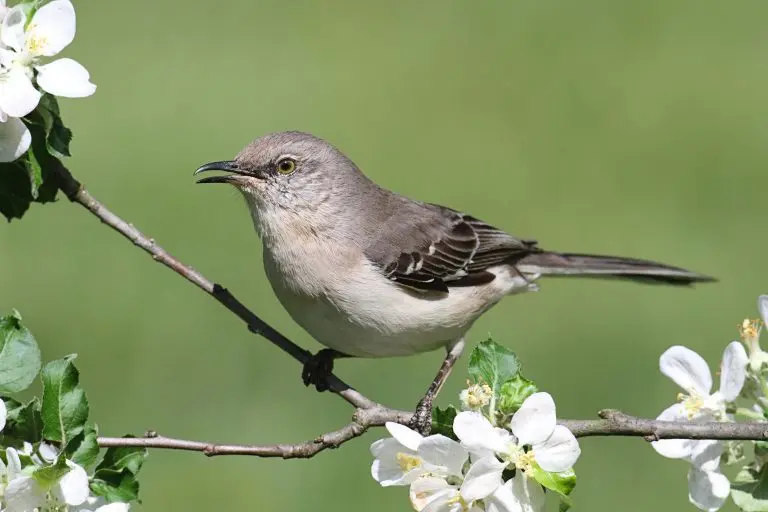
Northern Mockingbirds are medium-sized songbirds with small heads and long tails. They are a gray-brown color and slightly paler on the underside than their back, and they have two white wingbars visible in flight.
- Mimus polyglottos
- Length: 8.3-10.2 in (21-26 cm)
- Weight: 1.6-2.0 oz (45-58 g)
- Wingspan: 12.2-13.8 in (31-35 cm)
Northern Mockingbirds do not migrate and can be spotted across the lower 48 and southern Canada.
They are usually seen alone or in pairs and aggressively defend their territory. A male mockingbird can learn around 200 songs in its life, copying other birds’ songs, and they can sing all through the day and into the night.
Northern Mockingbird Call/Song:
Attract more Northern Mockingbirds to your backyard by planting fruiting trees or bushes, including hawthorns, mulberries, and blackberry brambles. They don’t often visit feeders, but they will come to open lawn areas.
17. Downy Woodpecker
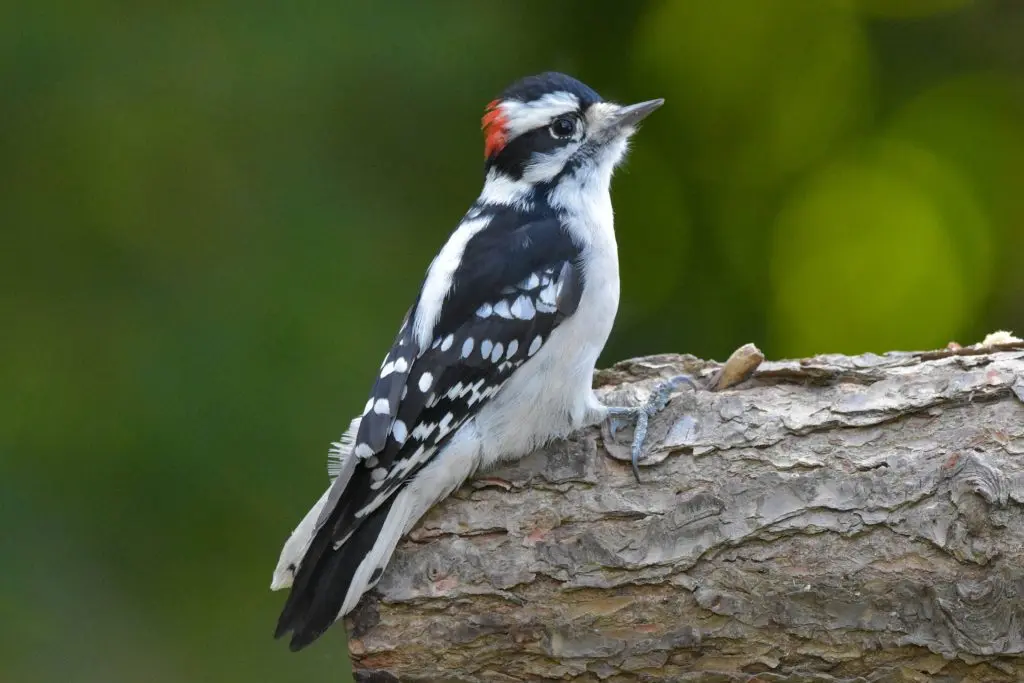
Downy Woodpeckers are small birds that are common at backyard feeders. They are often mixed in with other birds, such as chickadees and nuthatches.
They have black and white coloring with a red patch at the back of their heads. They look similar to the Hairy Woodpecker but smaller.
- Dryobates pubescens
- Length: 5.5-6.7 in (14-17 cm)
- Weight: 0.7-1.0 oz (21-28 g)
- Wingspan: 9.8-11.8 in (25-30 cm)
Downy Woodpeckers do not migrate and can be spotted in most states and provinces, except the north of Canada.
You can find Downy woodpeckers in woodlots, along streams, city parks, and backyards, and they eat mainly insects and beetle larvae but also berries, acorns, and grains.
Downy Woodpecker Call:
Attract Downy Woodpeckers to your backyard with their favorite treat of suet, but they will also eat black oil sunflower seeds, millet, and peanuts on platform feeders.
18. Western Tanager
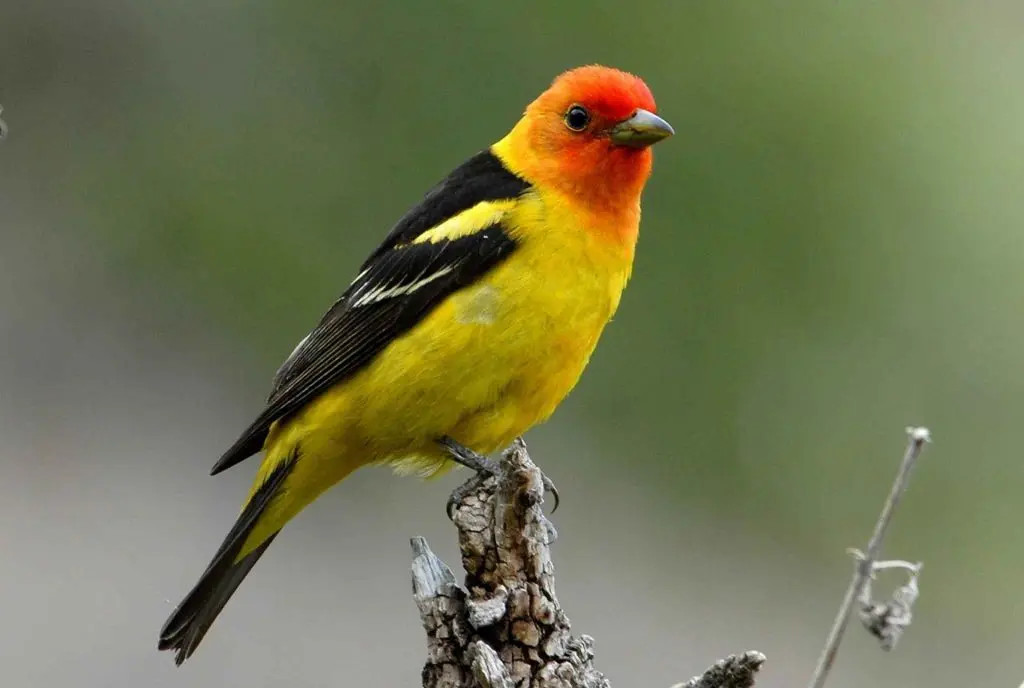
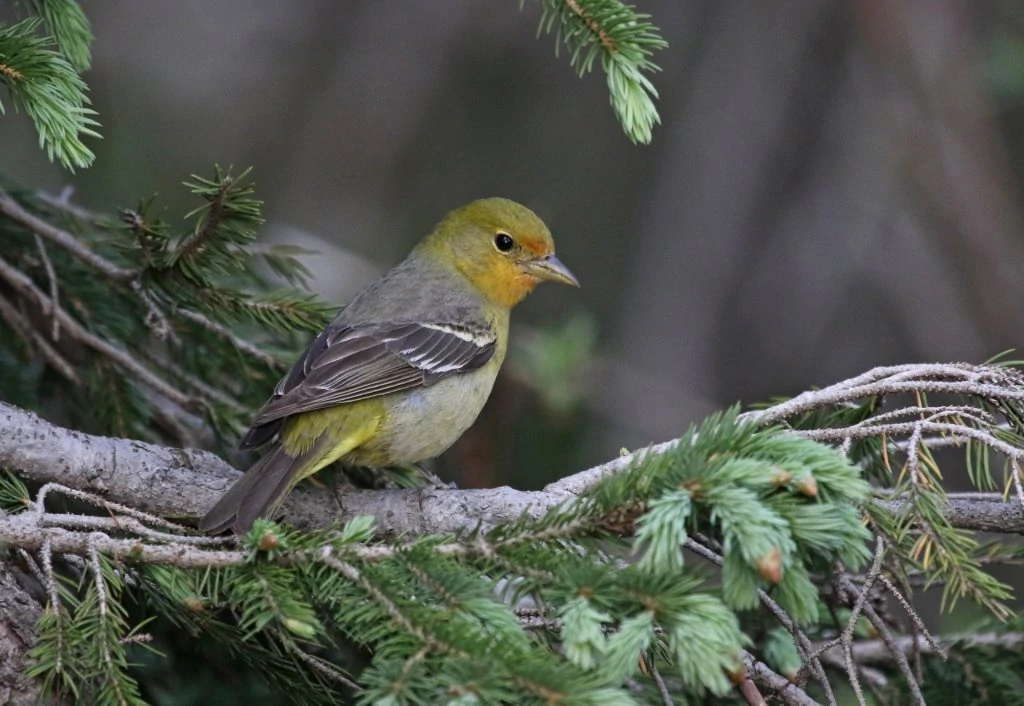
Western Tanagers have a flaming orange-red head, yellow body, and black wings. Females have only red faces, and their bodies are yellow-green.
- Piranga ludoviciana
- Length: 6.3-7.5 in (16-19 cm)
- Weight: 0.8-1.3 oz (24-36 g)
Western Tanagers breed in western US states and western Canada. They can be seen during migration in the east and south of this range. Winter is spent in Mexico and Central America.
You can find Western Tanagers in open conifer forests, but they stay hidden in the canopy, despite their bright coloring. Their numbers are actually increasing in the last forty years.
They eat mainly insects in summer, such as wasps and grasshoppers, and in the fall and winter, they also eat fruit.
Western Tanager Song:
Nests of Western Tanagers are built by females in open areas of trees and are made from large twigs and then roots and smaller twigs to weave them into a sturdy cup shape. The nest is lined with soft grass, pine needles, hair, and other plant materials. They lay around four eggs which take around two weeks to hatch.
Attract Western Tanagers with dried fruit, cut oranges, and other fruits from bird feeders.
Fun fact: Western Tanagers red coloring probably comes from eating insects that produce a pigment that they cannot produce themselves.
19. Hairy Woodpecker
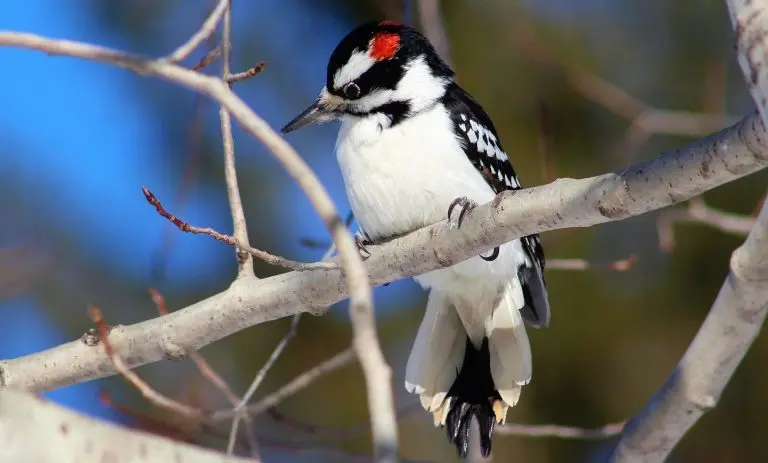
Hairy Woodpeckers are medium-sized woodpeckers with a black and white pattern and a large white patch on their backs. The males have a flash of red towards the back of their heads.
They are visually similar to Downy Woodpeckers but larger and with longer bills. As they are often found in the same areas, it is hard to tell them apart if they are not near each other.
- Dryobates villosus
- Length: 7.1-10.2 in (18-26 cm)
- Weight: 1.4-3.4 oz (40-95 g)
- Wingspan: 13.0-16.1 in (33-41 cm)
Hairy Woodpeckers do not migrate and live in all US states and Canada, except the far north of Canada.
You can find Hairy Woodpeckers in woodlands on trunks or main branches of large trees, but they are also found in a wide variety of habitats, including woodlots, parks, and cemeteries. Hairy Woodpeckers’ diet is mostly insects.
Hairy Woodpecker Call/drumming:
Attract Hairy Woodpeckers to your backyard with suet feeders.
20. Hepatic Tanager
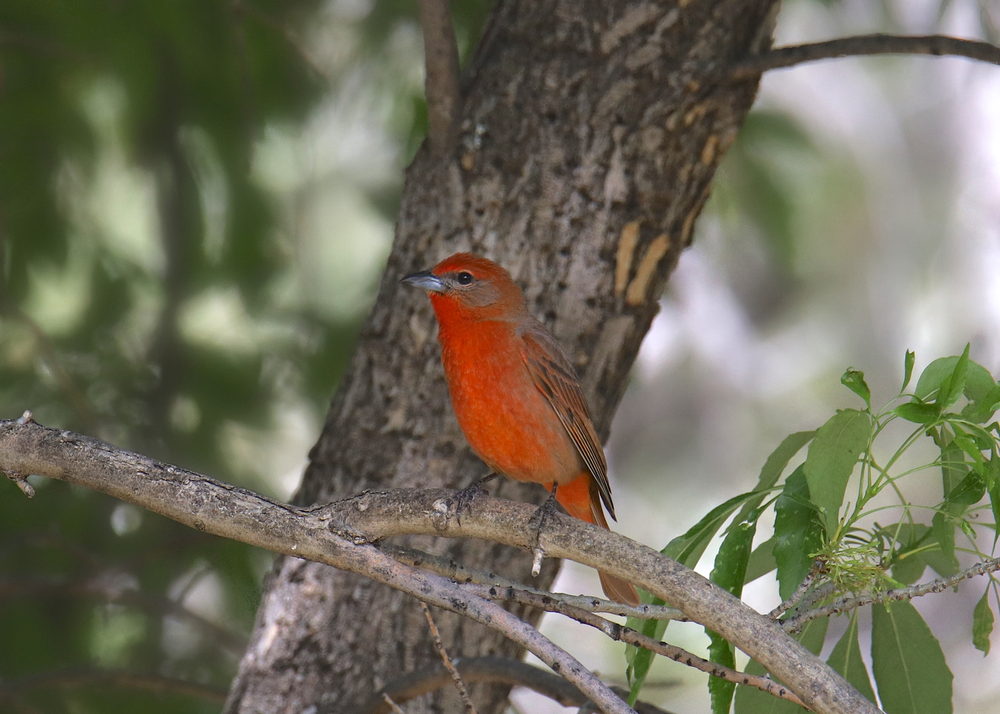
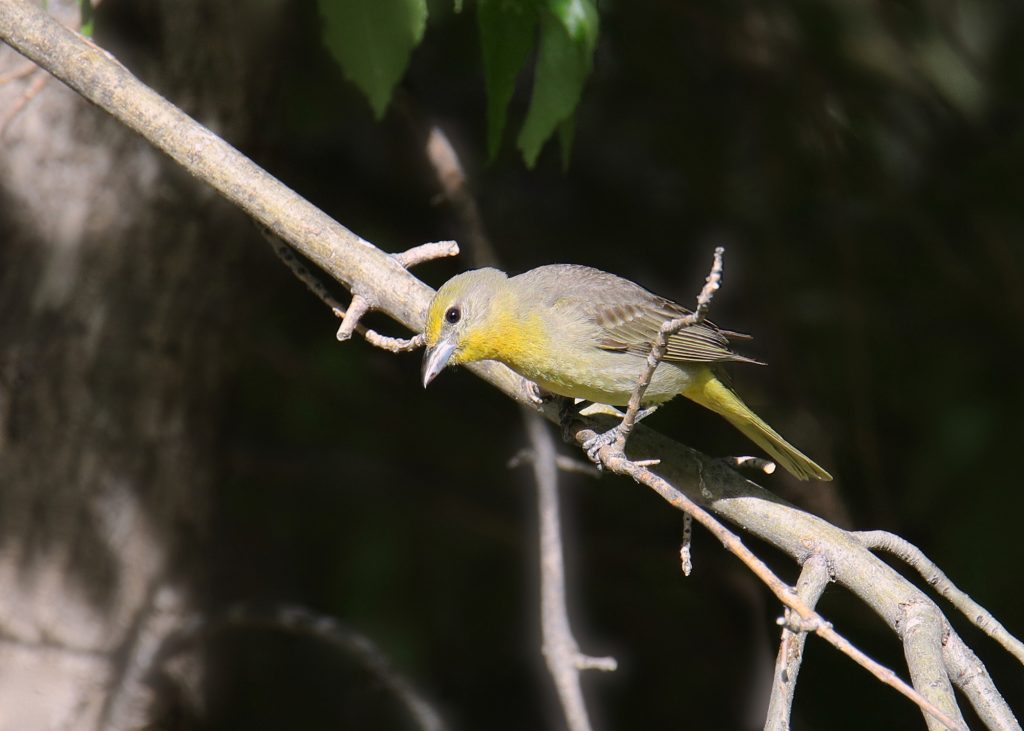
Hepatic Tanager males are stocky red birds with some gray on the back and their faces. Females are yellow, brighter underneath than on the back, and juveniles are similar to females.
- Piranga flava
- Length: 3.5-7.9 in (8.8-20 cm)
- Weight: 0.8-1.7 oz (23-47 g)
- Wingspan: 12.6 in (32 cm)
Hepatic Tanagers breed in southwestern states and Mexico before spending the winter in Mexico, Central, and South America.
You can find Hepatic Tanagers in mountain ranges with pine or pine and oak woodlands. They feed on insects and spiders, but also eat some berries such as cherry and grapes.
Hepatic Tanager Song:
Nests of Hepatic Tanagers are usually built by females quite high in trees and made from twigs, grass, and plant material. They line the nest with soft grass, hair, and pine needles. They lay up to five eggs.
Fun fact: Hepatic Tanagers often stay together as a family and may migrate together.
20. Flame-colored Tanager
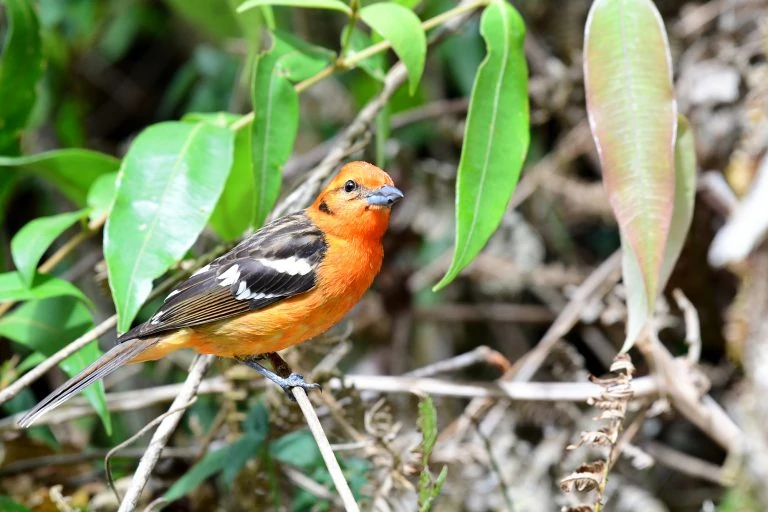
Male Flame-colored Tanagers are brightly colored birds with orange-red coloring, with darker wings and tails. Females are more yellow-orange.
- Piranga bidentata
- Length 7 – 7.5 inches (18 – 19 cm)
- Weight 1.13 – 1.71 oz (32 – 48 g).
A rare visitor to the US, the Flame-colored Tanager, has started breeding in Arizona and has also been spotted in Texas. They usually inhabit woodland Mexico and Central America.
Flame-colored Tanagers forage for insects in the treetops and berries near the ground.
Flame-colored Tanager Song:
Nests of Flame-colored Tanagers are made from twigs and grasses and can be placed anywhere from up in trees to down in shrubs in fairly open areas.
Fun fact: Flame-colored Tanagers will find lines of army ants carrying wasp larvae and have a bumper 2-4-1 meal of the ants and the wasp larvae.
21. Red-bellied Woodpecker
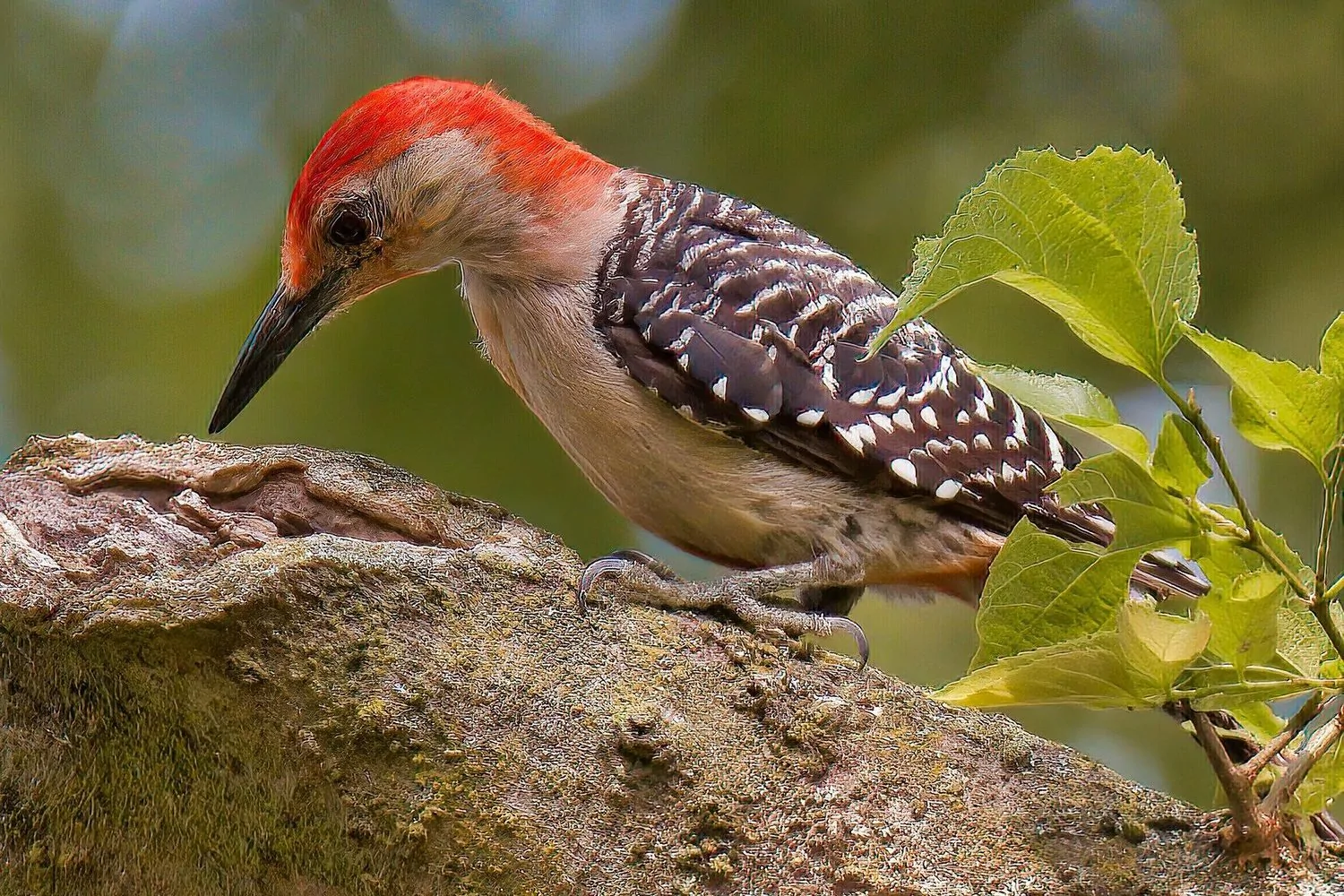
Red-bellied Woodpeckers can be mistaken for Red-headed Woodpeckers as they have red caps, but they are much smaller than the Red-headed Woodpecker. Female Red-bellied Woodpeckers lack the red cap and only have red at the back of their heads.
They also have a very pale red belly that can be hard to spot, but they do have the typical woodpecker black and white markings over their backs.
- Melanerpes carolinus
- Length: 9.4 in (24 cm)
- Weight: 2.0-3.2 oz (56-91 g)
- Wingspan: 13.0-16.5 in (33-42 cm)
Red-bellied Woodpeckers can be found in eastern US states, and they do not migrate.
Red-bellied Woodpeckers eat insects, spiders, seeds from grasses, fruit, and nuts. They will also sometimes eat nestlings. They nest in dead trees and may use the same nest year after year. They lay 4-5 white eggs on a bed of wood chips.
The tongue of the Red-bellied Woodpecker sticks out 2 inches past the beak and is barbed at the tip, along with sticky spit. This helps catch prey from deep crevices.
Red-bellied Woodpecker Call:
Red-bellied Woodpeckers can often be seen at bird feeders, especially if you live near wooded areas. They make a distinctive loud rolling call which means you will often hear them before you see them.
22. Brown Thrasher
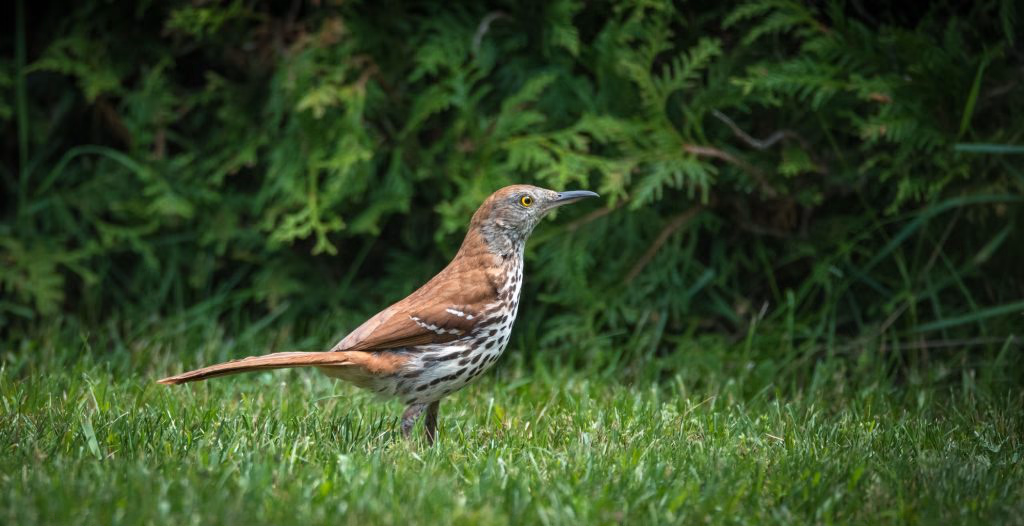
Brown Thrashers are large songbirds with long proportions. They are about the same size as a robin. They are brown on the back and with white-streaked chests and bellies. Their faces are gray with bright yellow eyes.
- Length: 9.1-11.8 in (23-30 cm)
- Weight: 2.1-3.1 oz (61-89 g)
- Wingspan: 11.4-12.6 in (29-32 cm)
Brown Thrashers live in central and eastern North America. Those birds in the southeast of their range remain all year, but birds further north migrate south for the winter.
Brown Thrashers are hard to spot for their size as they spend most of their time in thickets and shrubbery. However, they can be heard rummaging along the ground in the leaf litter and soil, looking for insects.
Brown Thrashers also eat berries, beetles, and flying insects from the air. They may come to your backyard if there is dense cover and berry shrubs and they collect fallen seed from under feeders.
Over 1000 different song types are sung by these most accomplished songbirds, which is one of the largest of any North American songbird.
23. Anna’s Hummingbird
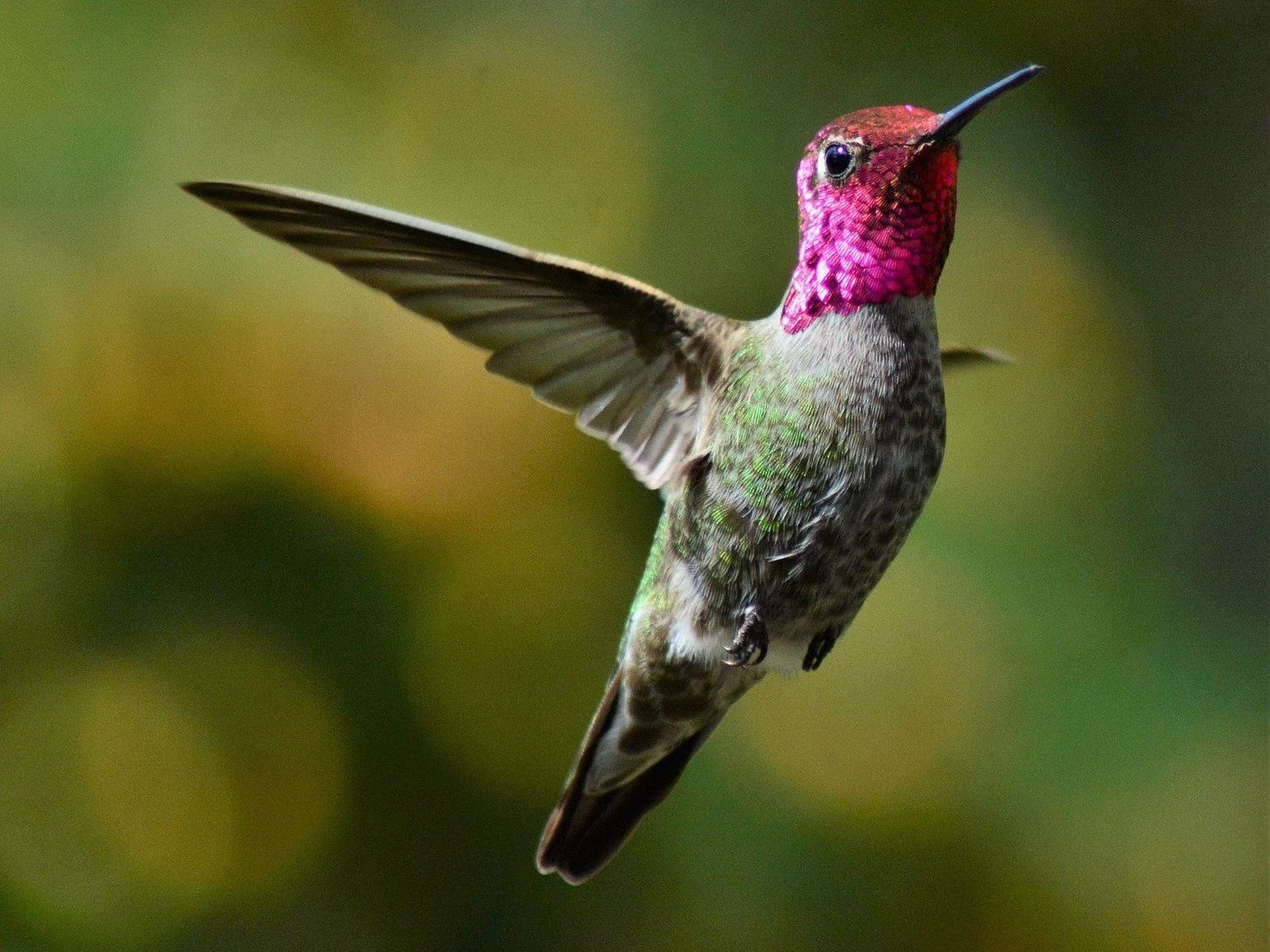
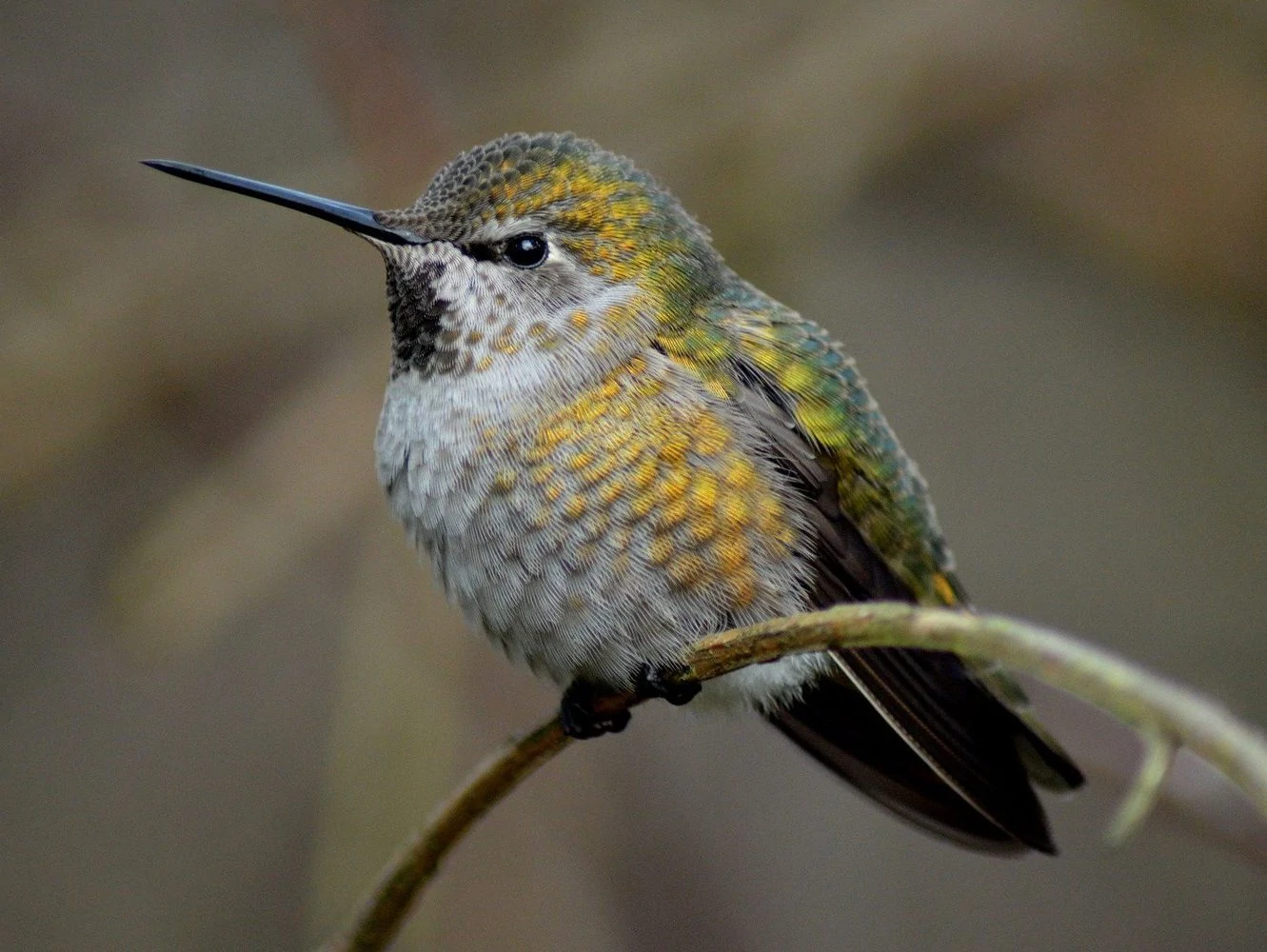
Anna’s Hummingbirds are tiny birds that are primarily green and gray. The male’s head and throat are iridescent reddish-pink. The female’s throat is grayish with bits of red spotting.
- Length: 3.9 in (10 cm)
- Weight: 0.1-0.2 oz (3-6 g)
- Wingspan: 4.7 in (12 cm)
Anna’s Hummingbirds are the most common hummingbird along the Pacific Coast and they do not migrate, which is unusual for hummingbirds.
Their range is from British Columbia to Baja California in both summer and winter. However, some birds may move from the far north of their range for winter.
Habitats of Anna’s hummingbirds are often backyards and parks with large colorful blooms and nectar feeders, but they are also found in scrub and savannah.
The diet of Anna’s Hummingbirds includes nectar, tree sap, and small insects and spiders. Nectar sources are Eucalyptus, Nicotiana, Agave, Castilleja, Diplaucus, Ribes, Silena, Arctostaphylos, and nectar feeders.
Anna’s Hummingbird call sounds:
Anna’s Hummingbirds’ nests are high up in trees at around 6 – 20 ft, and they often have 2-3 broods a year, and female hummingbirds do all of the work!
They make dramatic dive displays during courtship as the males climb up to 130 feet into the air before diving back to the ground with a burst of noise from their tail feathers.
24. Ruby-throated Hummingbird
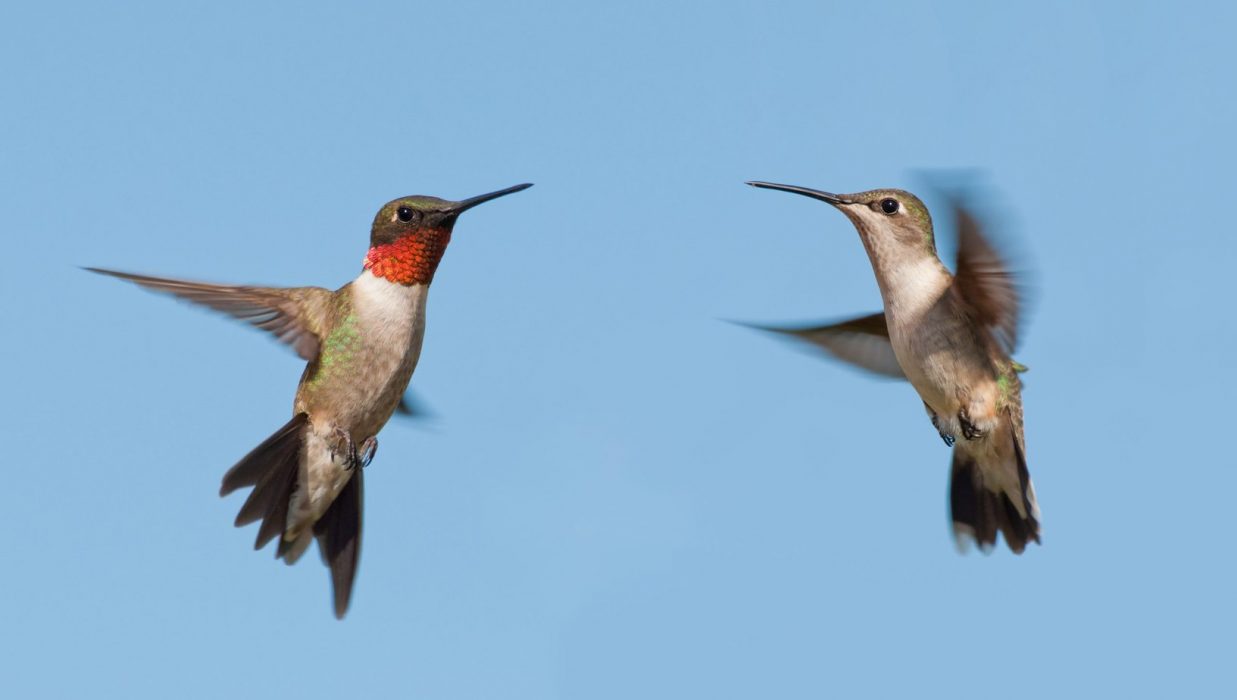
The Ruby-throated Hummingbirds are bright green on the back and crown, with a gray-white underside and the males have an iridescent red throat.
Female Ruby-throated Hummingbirds are green on the back and white underneath with brownish crowns and sides.
- Length: 2.8-3.5 in (7-9 cm)
- Weight: 0.1-0.2 oz (2-6 g)
- Wingspan: 3.1-4.3 in (8-11 cm)
The Ruby-throated Hummingbird is the only breeding hummingbird in eastern North America. They then migrate further south to Central America for winter. Some migrate over the Gulf of Mexico, or some migrate through Texas around the coast.
Ruby-throated hummingbirds start arriving in the United States in February and may not arrive in northern states and Canada until May for breeding. In spring, males usually arrive first up to one or two weeks before the females.
In the fall, Ruby-throated Hummingbirds migrate south in August and September and gather in September along the Gulf Coast of Texas before making the final push south for winter.
These tiny birds zip from one nectar source to the next or catch insects in midair or from spider webs. They occasionally stop on a small twig, but their legs are so short they cannot walk, only shuffle along a perch.
In summer, flowering gardens or woodland edges are the best places to find them. They are also common in towns, especially at nectar feeders.
Ruby-throated Hummingbird calls and wingbeat:
Male Ruby-throated Hummingbirds can be aggressive in their defense of flowers and feeders. Males do not stick around long after mating and may migrate by early August.
Ruby-throated females build nests on thin branches and make them out of thistle or dandelion down held together with spider silk. They lay 1-3 tiny eggs measuring only 0.6 in (1.3 cm)
25. Rose-breasted Grosbeak
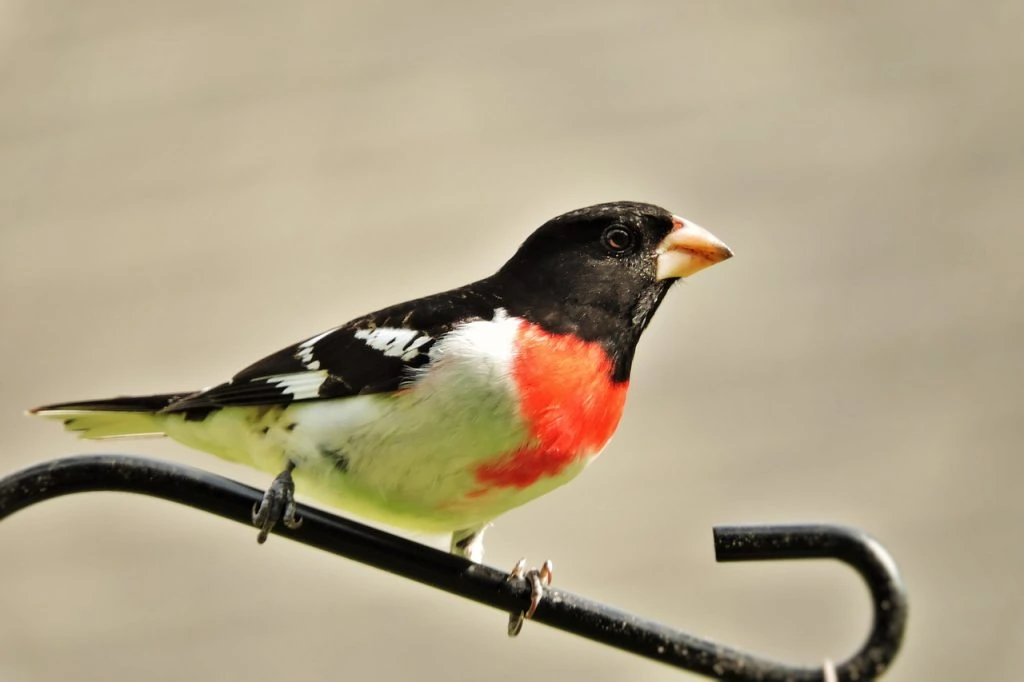
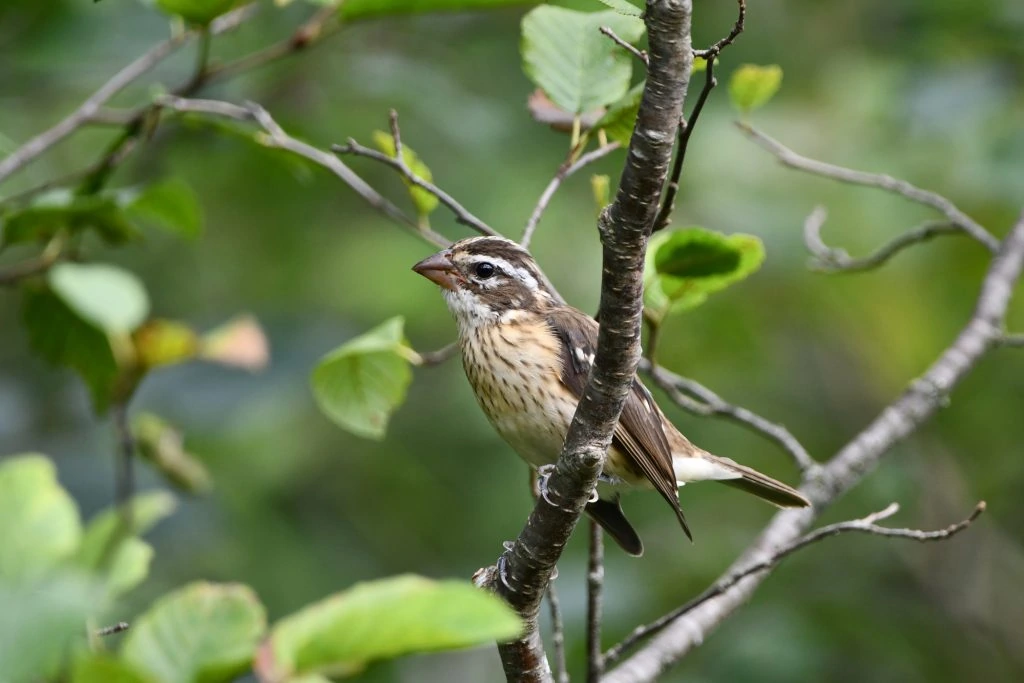
Rose-breasted Grosbeaks males are black-and-white birds with black heads and backs, white bellies, and red breasts. They also have a flash of red under their wings.
Female Rose-breasted Grosbeaks and immature males are brown with lots of streaking and a flash of yellow under the wings.
- Pheucticus ludovicianus
- Length: 7.1-8.3 in (18-21 cm)
- Weight: 1.4-1.7 oz (39-49 g)
- Wingspan: 11.4-13.0 in (29-33 cm)
Rose-breasted Grosbeaks breed in northeastern US states, the Midwest, and southern and central Canada. They can be seen during migration in southeastern US states. Winter is spent in Mexico, Central America, and the Caribbean.
Rose-breasted Grosbeaks Song:
Attract Rose-breasted Grosbeaks to your backyard with sunflower seeds and peanuts.

